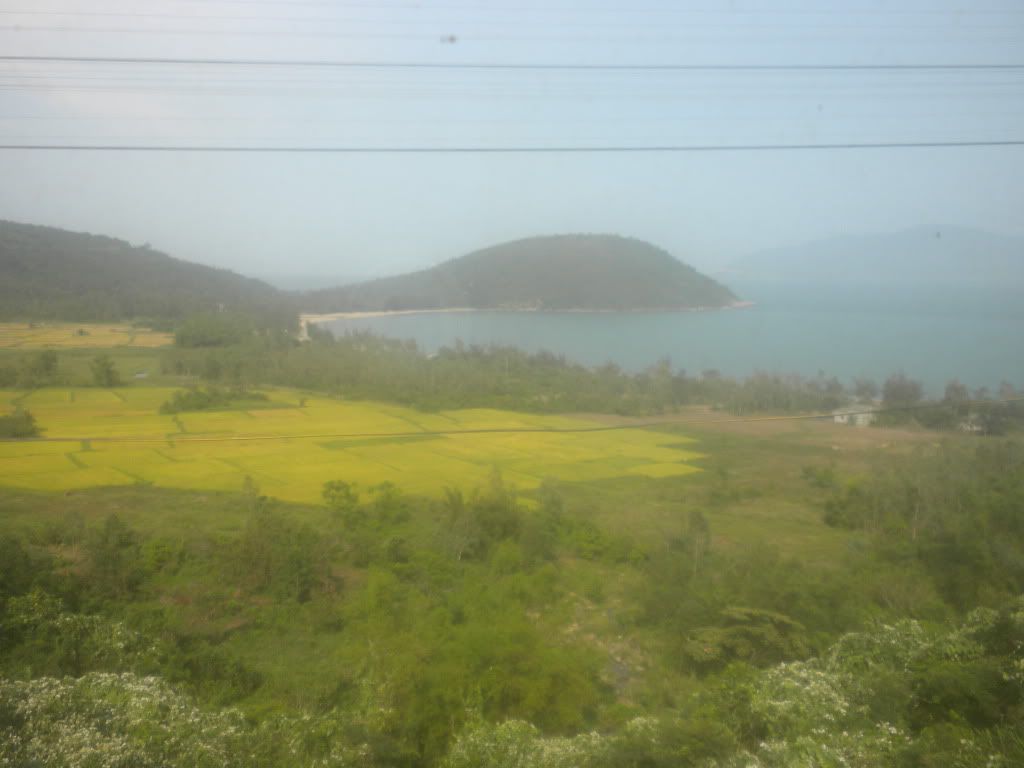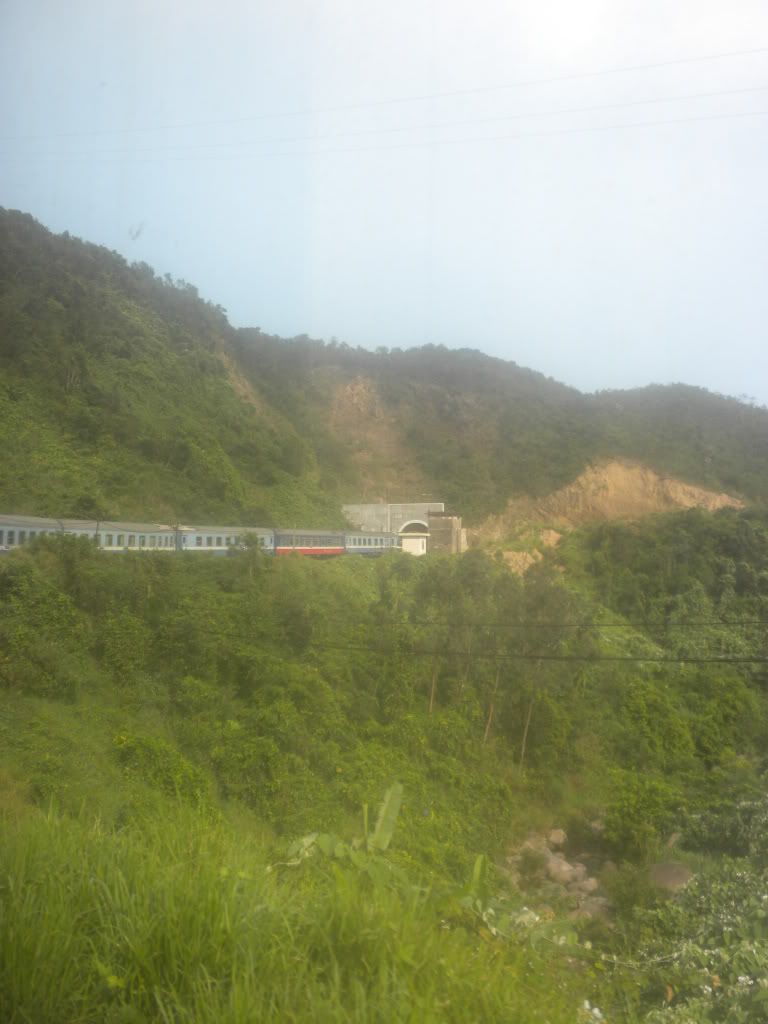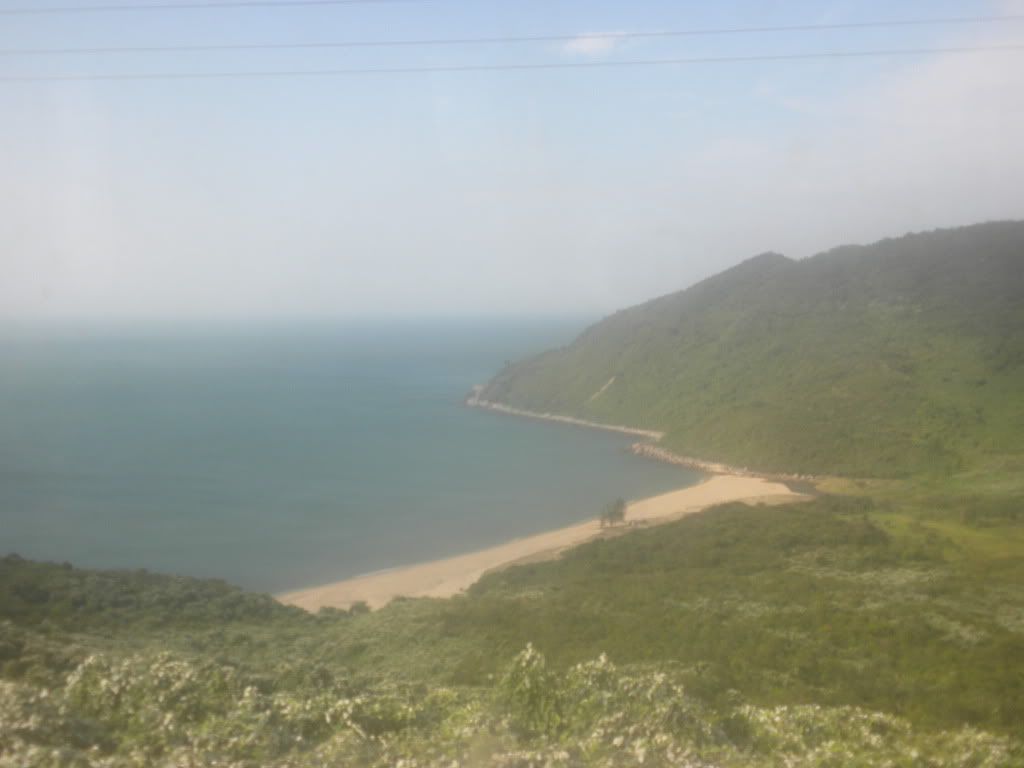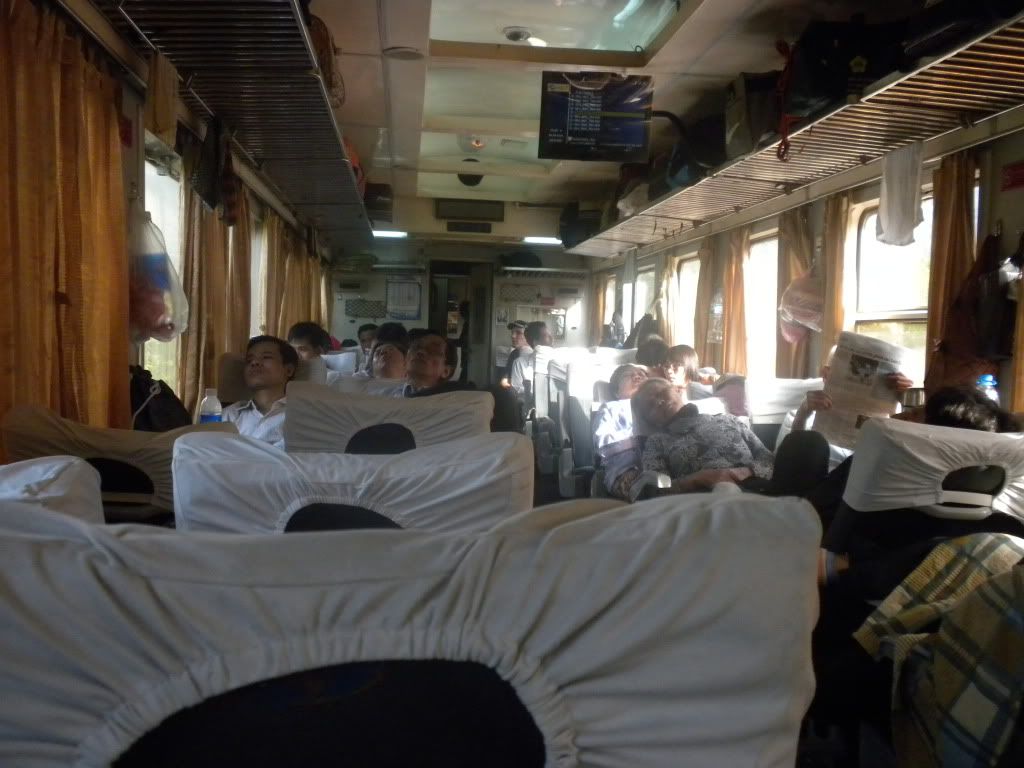Francesca and Henk-Jan's Backpacking Trip!
Friday, April 23, 2010
Hue Celebrates My Golden Birthday!
Henk had been furiously running around the city of Hue planning my birthday the two days before, making sure I’d have a perfect golden birthday. I knew what he was up to but had no idea about the details until the day of! The 22nd I relaxed in the room (or I tried to anyways… I had gotten a bit sick, probably something I ate, and I couldn’t keep anything in my stomach) while he went out numerous times to “pick something up” or “get something arranged.” I didn’t know what was going on, but I was excited!
When I woke up on the 23rd, Henk presented me with some awesome presents right away: a beautiful bouquet of 22 roses with 1 lily symbolizing my 23rd. The lily made a fantastic addition, adding a splash of white in the middle of the roses. There were also tiny purple flowers all around the roses to enhance the bulk and beauty of the flowers. To my delight the entire bouquet was incredibly sparkly… it had been sprayed with silver sparkles and smelled so fresh! As an added bonus, Henk had designed the decorative netting that surrounded the roses… purple and gold, purple because it’s my favorite color and gold because of my golden birthday! I was very excited to receive roses, because although I have gotten flowers before… never roses! Yay!
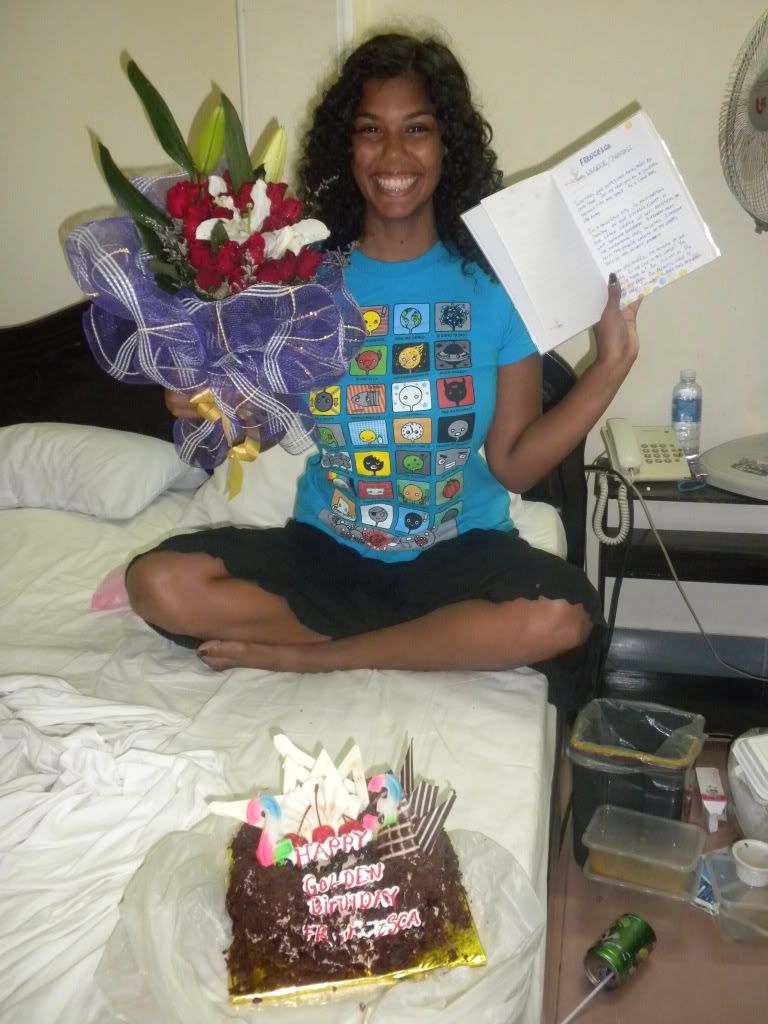
Before he came back with the flowers, Henk had presented me with a small envelope. I opened it and found a card inside which explained to me he would be gone for a little while to pick a few things up. Once he returned, he gave me a second card which told me to check the fridge… inside I found my awesome birthday cake! Extremely chocolate-y, the cake was decorated with large chocolate pieces and had a smooth chocolate filling punctuated by chocolate chips in each layer. Awesome!! Part of the description I ate off since it got a little smudged before the picture, but I still think you can all read what it says.
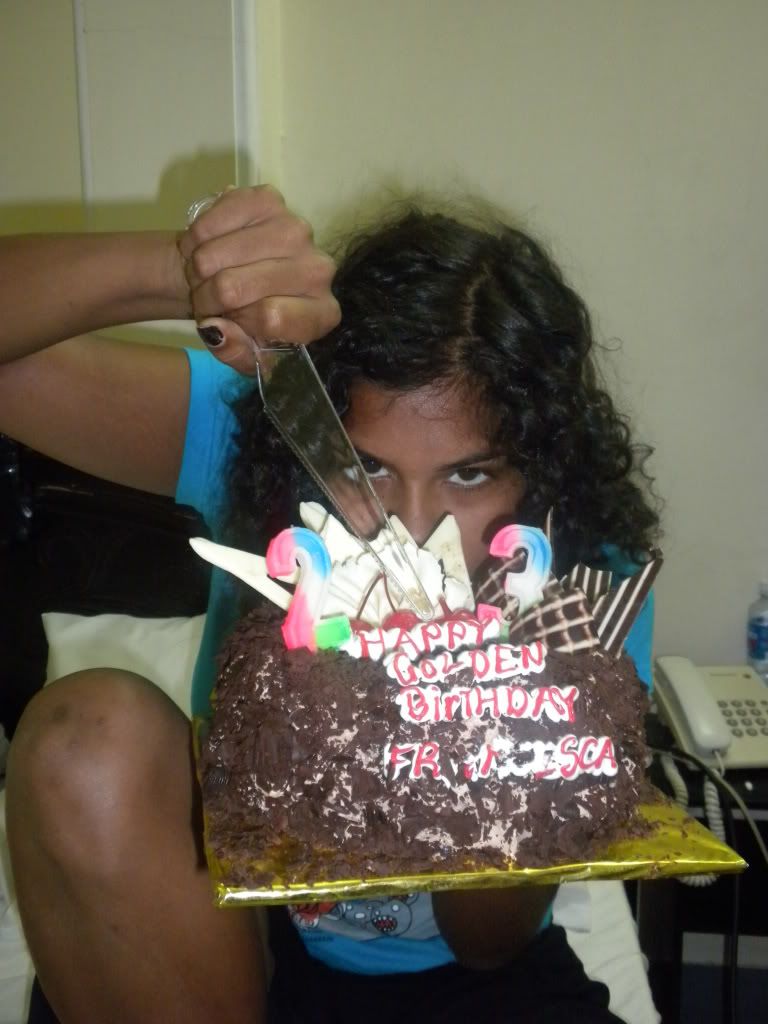
After we each had a slice of cake and stored the rest away, Henk gave me a little baggie of additional cards, plus my main present which was a story he wrote me along with a book and promise of more stories to come. On my request! Now that’s the kinda gift I like… the one I can demand more of! But the presents weren’t over yet! I was informed that we’d be going to breakfast. As we came down the stairs and headed towards breakfast I quickly realized that *everyone* already knew it was my birthday! I was congratulated downstairs by the staff, by the waitress and owner once we got to the restaurant, and throughout the rest of the day by others we ran into. Henk had informed the city of Hue that it was my birthday!
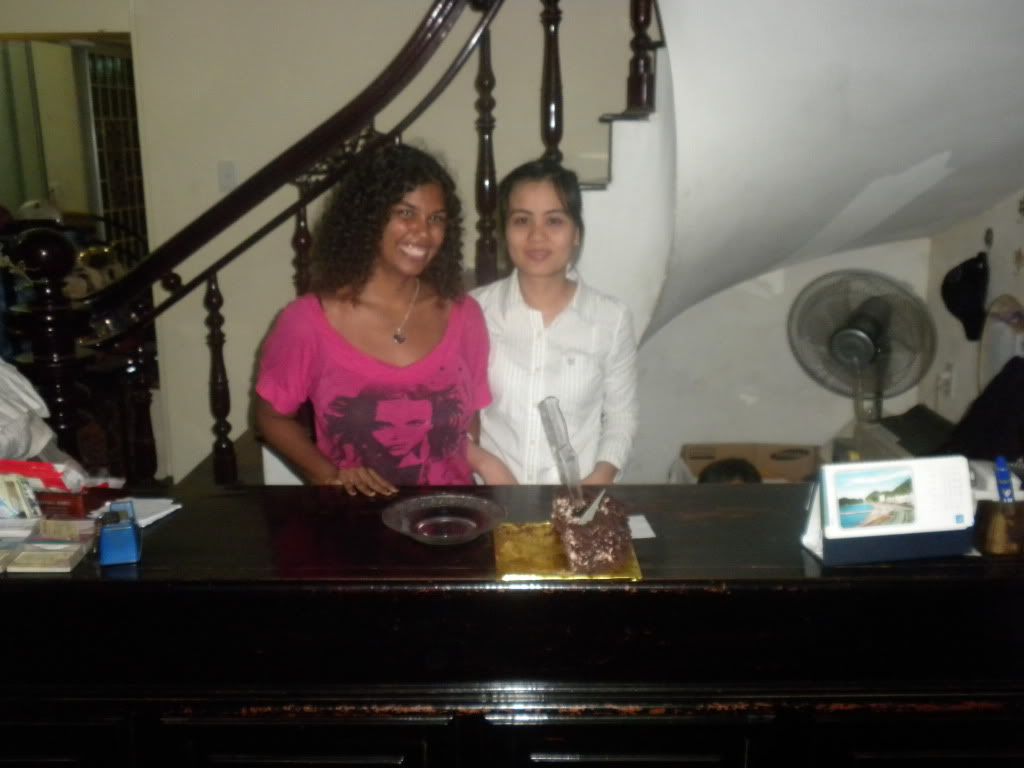
I had no idea at the time, but Henk had pre-ordered some tasty things for us at a really neat restaurant, Hot Tuna, before we got there. Once we sat down we were immediately brought two large orange juices, fruit salad, and a chocolate-banana pancake. This followed with croissants, cheese, butter, jelly, and a baguette. Wow, we had not had breakfast like this in a while…
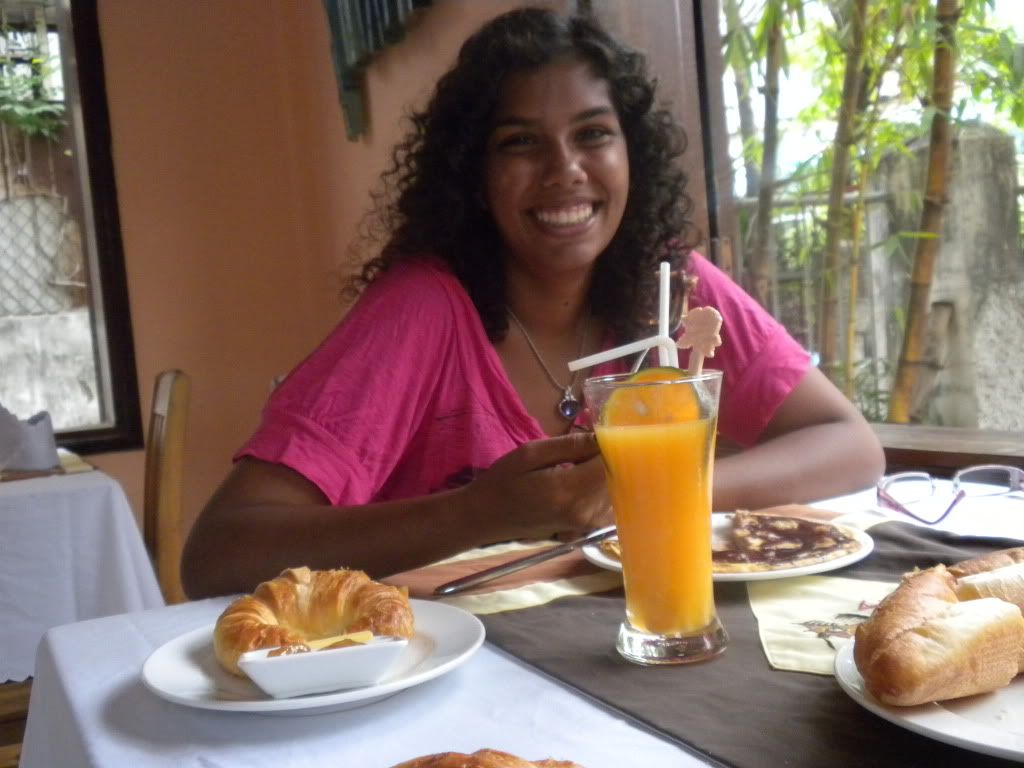
After eating, we went back to the hotel to rest up for a little while before the next events of the day. When we got into the room, I noticed a little purple box on the bed. More gifts! Henk had found us a sweet-looking magnetic keychain that split apart and snapped together again. Perfect for our future apartment keys! A short while later we were out again after I read my next card, which said something about ‘enjoying bubbles’ that I didn’t understand. We arrived at the Rose Spa and sent to get changed, before being shown the steam room/sauna area. First we sweated it out in the steam room before heading to the sauna. I wasn’t sure how much water to pour on the coals in the sauna… but it might have been a little too much because very quickly we were roasting! Next we were treated to a traditional Vietnamese couples’ massage and then a romantic, candle-lit hot-tub bath complete with sparkling wine. So that’s what bubbles meant!
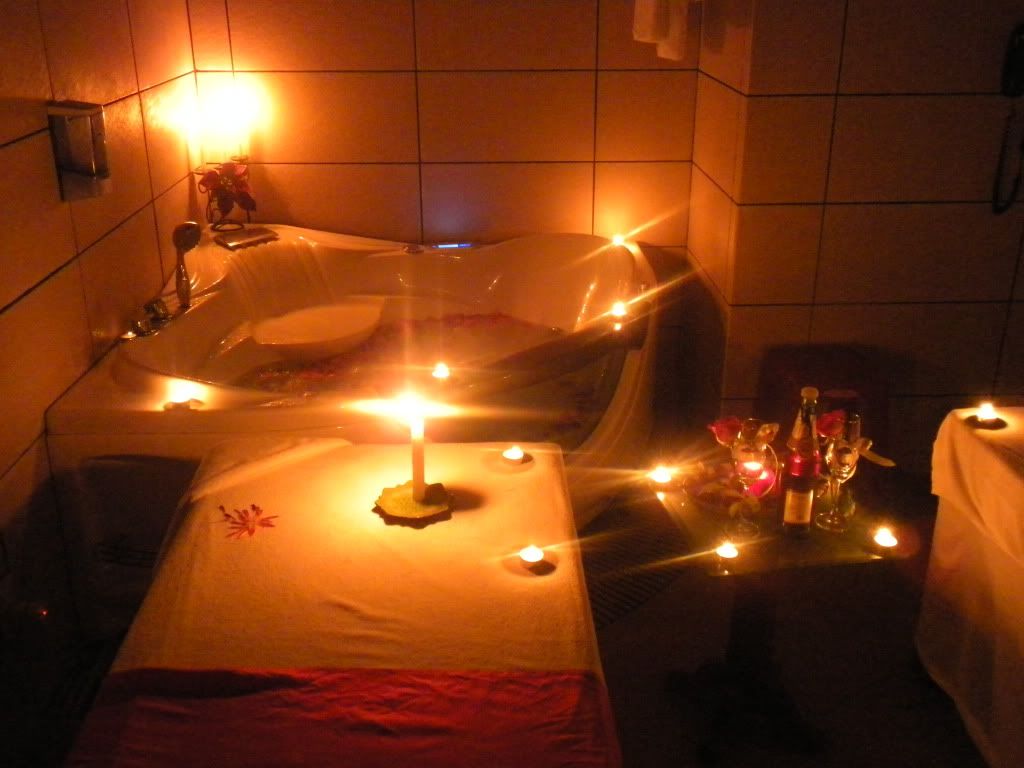
After our time at the spa, Henk gave me another card inviting me to a set-menu lunch. We walked next door from the spa and shared a Vietnamese sampler platter of traditional Hue delicacies, including their famous shrimp pancake. I really enjoyed the chicken cakes with ketchup dipping sauce. Oh! Because it was my birthday, we even got a free extra soup on the set menu!
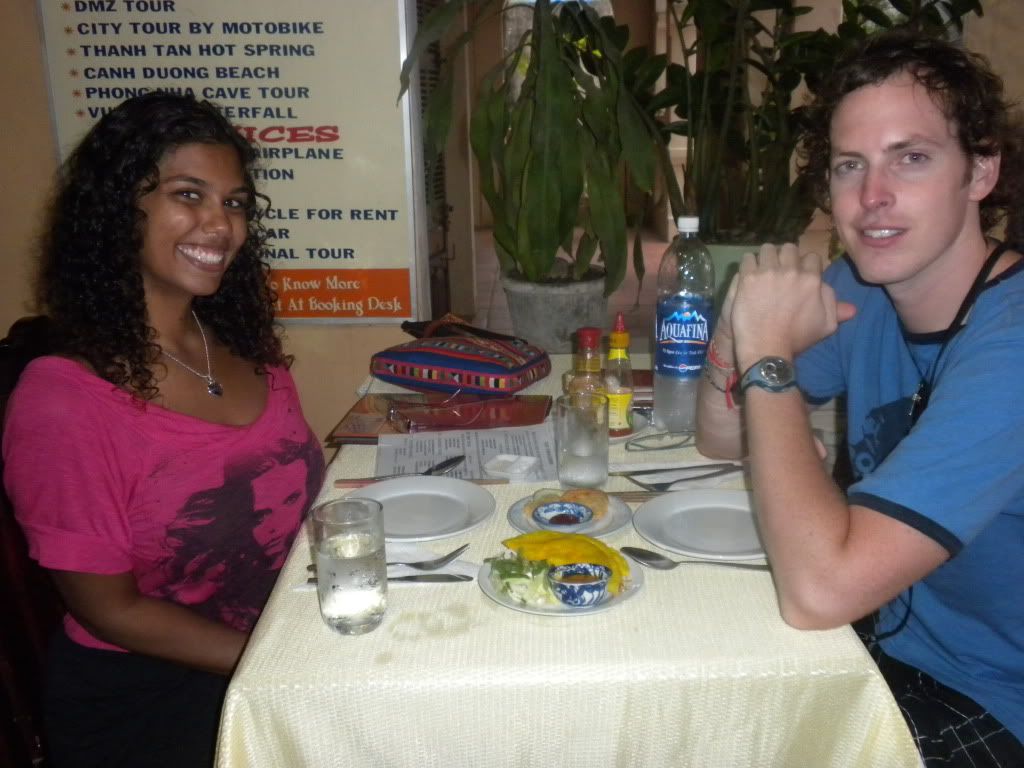
Dinner that evening was my choice, the final card of the day explained to me in a creative rhyming poem. Henk had wanted to cover all the bases, so he ended up making reservations at two separate restaurants he found in town. No matter if I was craving Indian or Italian (my two favorite cuisines) he had it planned! He even went so far as to reserve a special separate table in each place so we’d have our privacy.
I opted for Italian so after a little more time relaxing we headed for a dinner of assorted bruschetta, home-made spaghetti with tomato sauce, and home-made ice-cream – vanilla and stracciatella (which is like chocolate-chip ice-cream). Stomachs full we ended our evening back in the hotel, planning to sleep-in the next morning.
Wednesday, April 21, 2010
The Ancient City Of Hue
Hue used to be the capital of Vietnam and the Imperial City was its palace. A walled city fortress, this area was surrounded by a boat and included the “Purple Forbidden City,” the area dedicated to housing the Nguyen royal family. The wiki can better explain some of the background of the city:
“It was in 1802 that Nguyễn Phuc Anh took control of Vietnam and proclaimed himself Emperor Gia Long. His rule was recognized by China in 1804...(A sidenote from me: The building of the Imperial City started in 1804, finished in 1833, and the city served as the center of government until 1945)… The American bombing in 1968 in response to a communist takeover of Hue flattened most of the Imperial city. Only a few buildings survived, such as the Thai Hoa Temple, Can Thanh Temple, The Mieu, and Hieu Lam Cac.”
We walked with our guide to see some of the few surviving buildings that withstand American bombs. He informed us that there are three parts to the old city: the Citadel, the Imperial City, and the Forbidden Purple City. There were also 5 entrances to the city: the middle for the king, the left for ministers, the right for military, and some further entrances for elephants. We started our exploration by walking through the Noon Gate. Upon walking closer to the buildings I noticed that many of the roof tops were decorated with a detailing of awesome faux gold coins that I just loved.
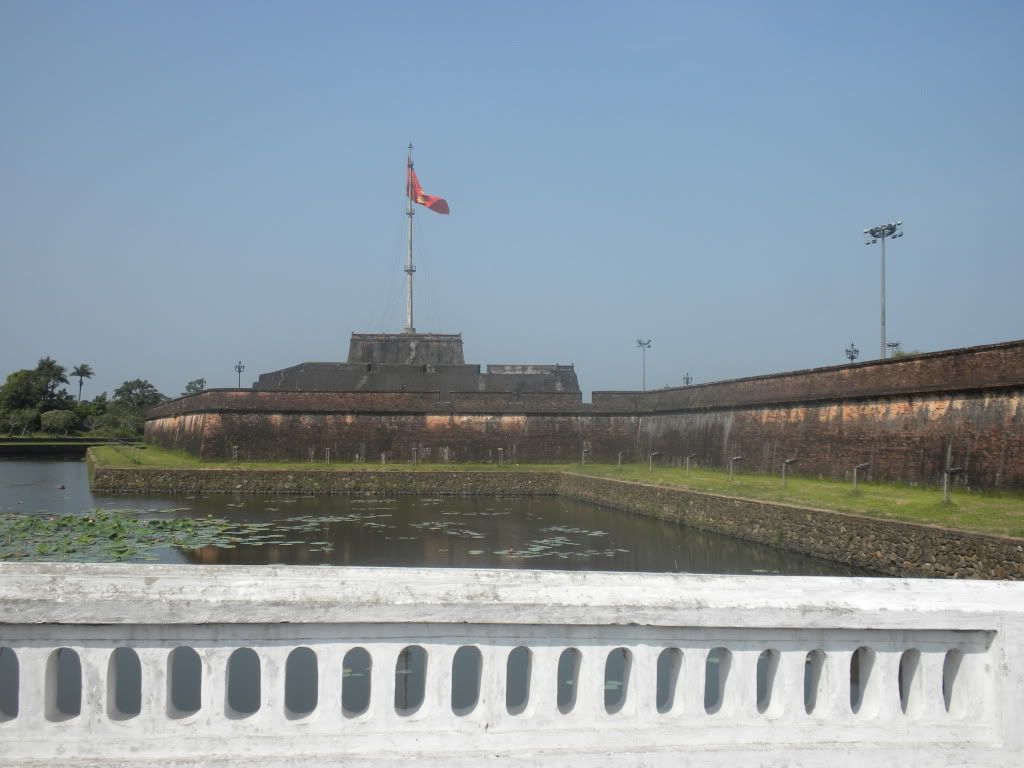
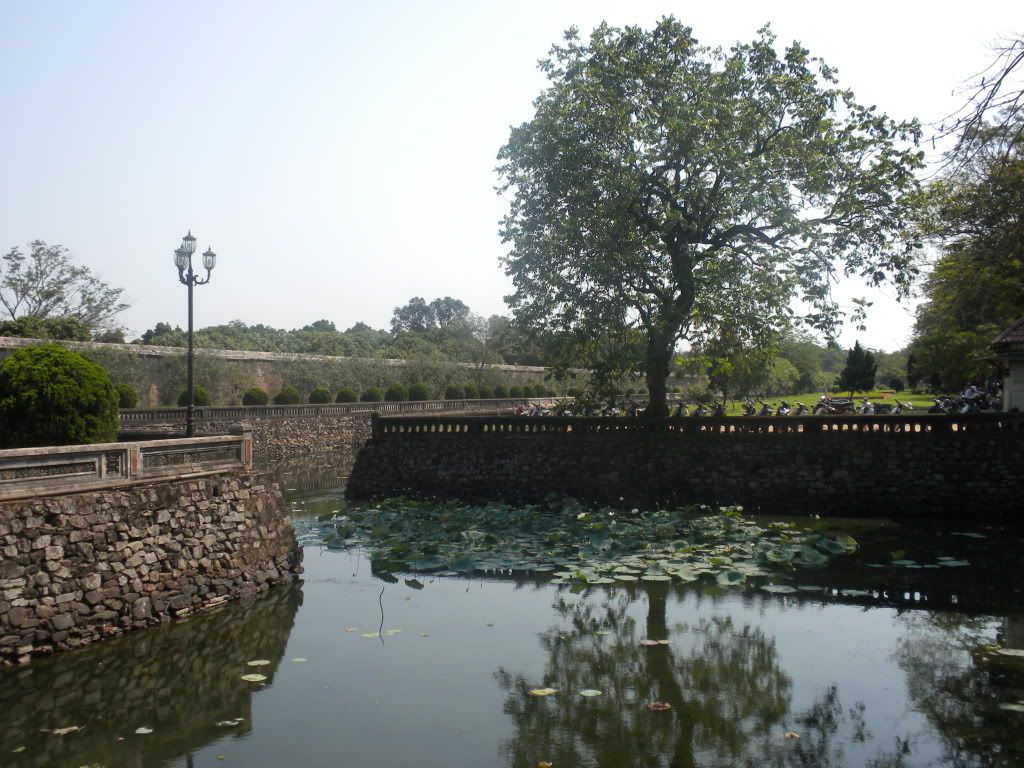
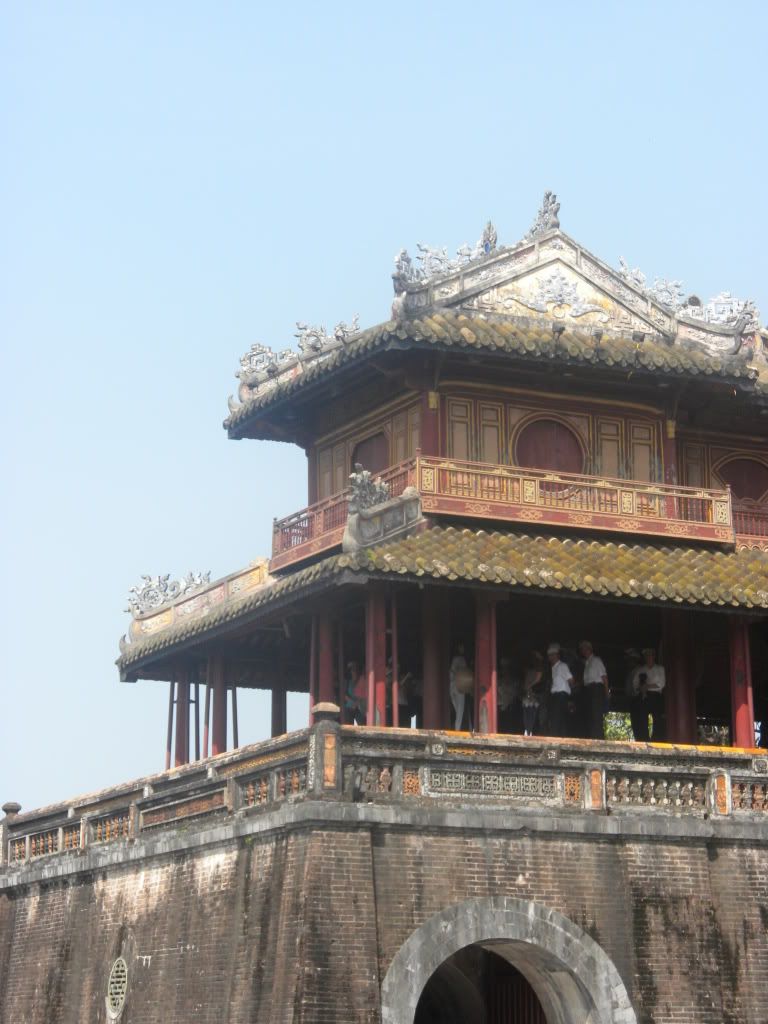
The Thai Hoa Palace area contained the king’s throne and was very pretty, decorated in red and gold. This palace area was where, according to the display plaques, the king held audiences of the Nguyen court and where he presided over ceremonies. Chinese poems were written on the walls. Many of these poems described the 4 powerful animals: the Dragon (representing the king), the phoenix (representing beauty), the turtle and the unicorn. We also looked at the throne, which is made of gold and thus very fragile and valuable.
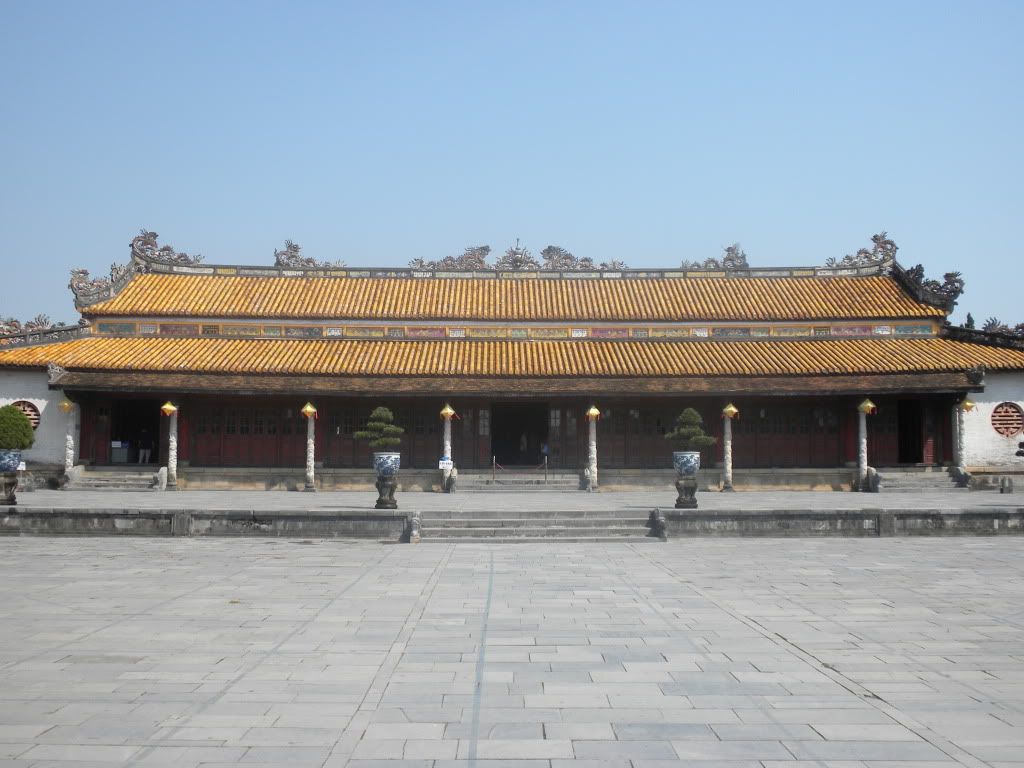
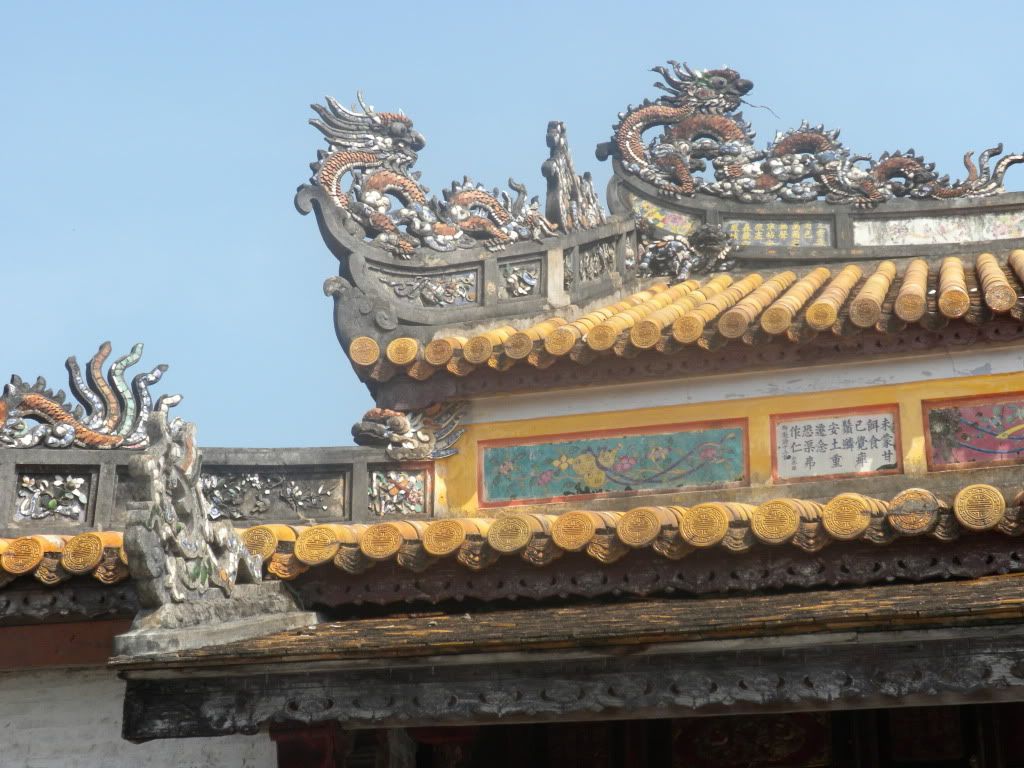
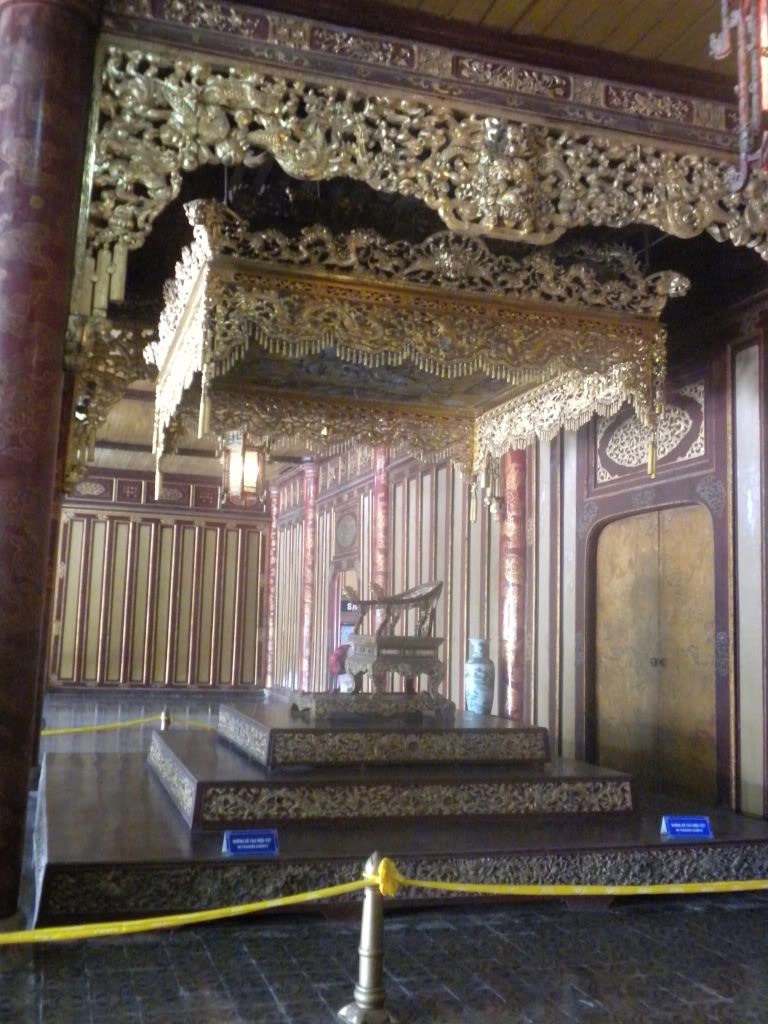
Exiting this area, we paused for a few minutes to watch a short video on the area, showing the digitized images of what the city would have looked like if it was still standing. Next we did a quick tour of the mandarin’s offices on the left and right of the pavilion. These buildings had been used as administrative offices, national exam halls, and banquet rooms. One of the office areas is now used as a mini-museum displaying some of the artifacts from the times. It was extremely sad to walk further and see the reconstruction area towards the back of the complex -- so much work to do and so much of the original buildings lost.
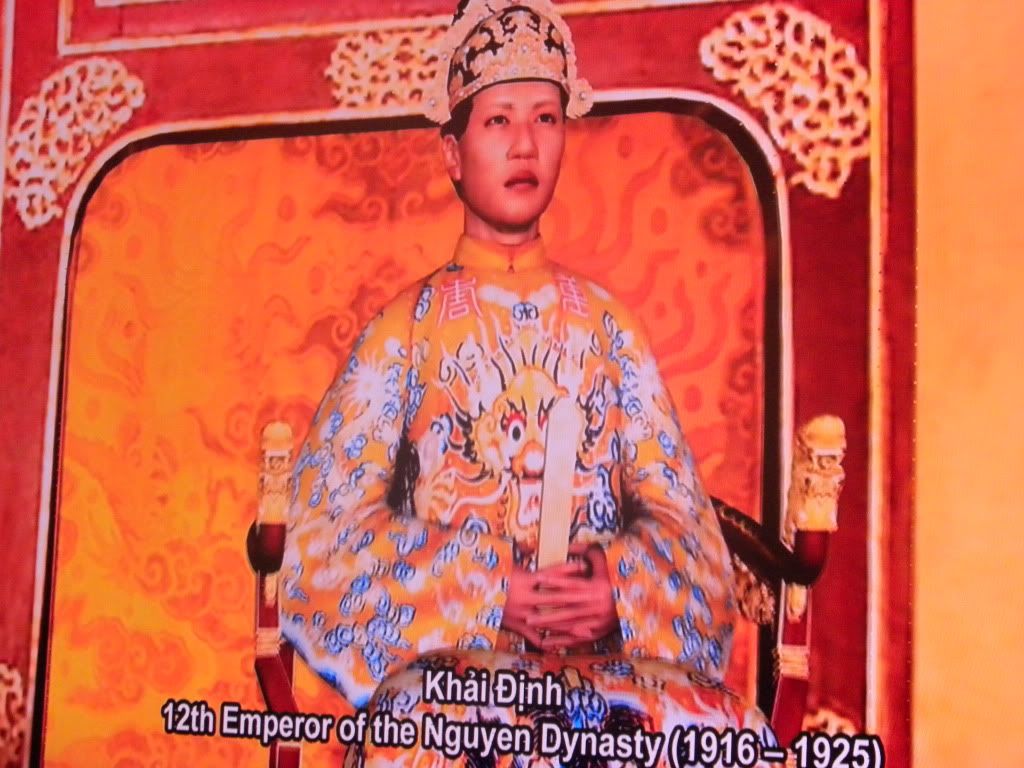
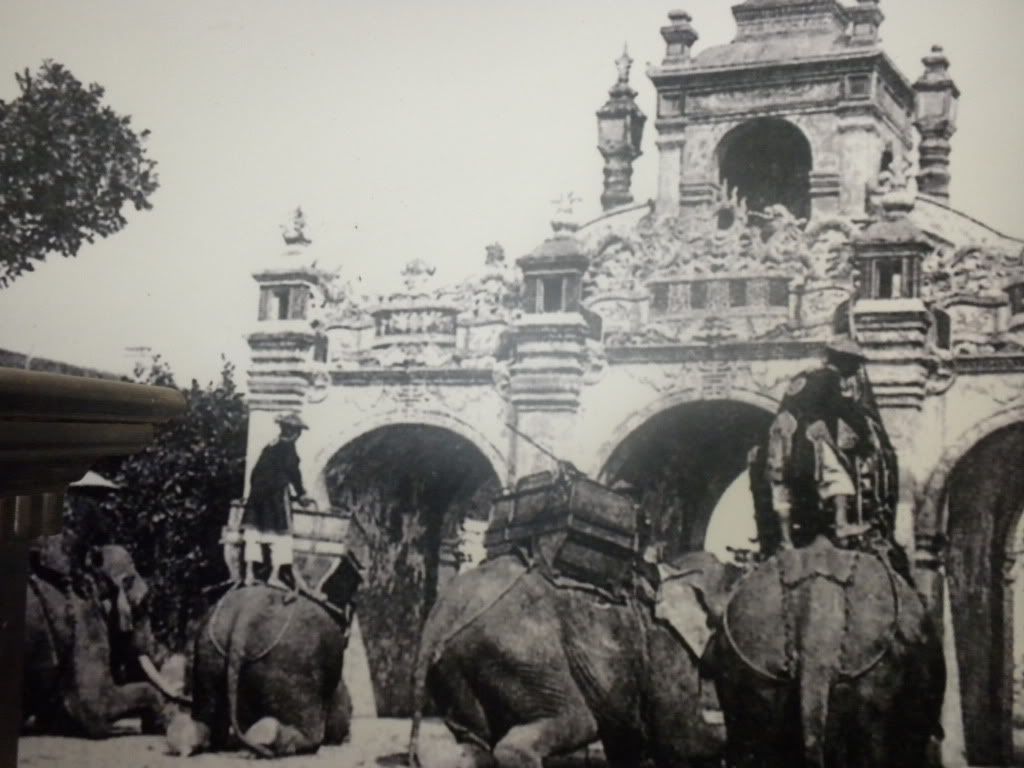
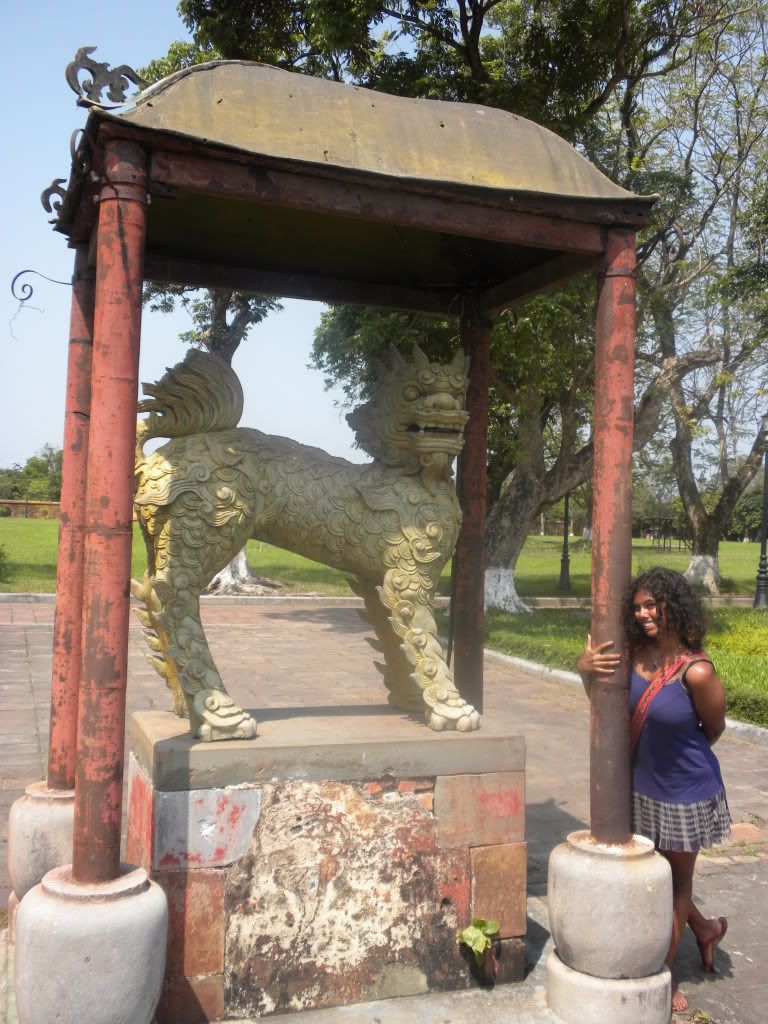
After the city we had a short break of tea and snacks before heading to our next stop. After learning about the mandarins who served the king, we were now going to visit one of their former houses. The house itself proved very sturdy, made of ironwood which helps to keep spiders away (don’t ask me how, something to do with the smell they don’t like) and makes the whole place look very elegant and formal. The family alter in the center of the house was the first thing we saw entering the house, and that area combined with the beauty of the gardens outside turned the whole place into a calm oasis in the middle of Hue.
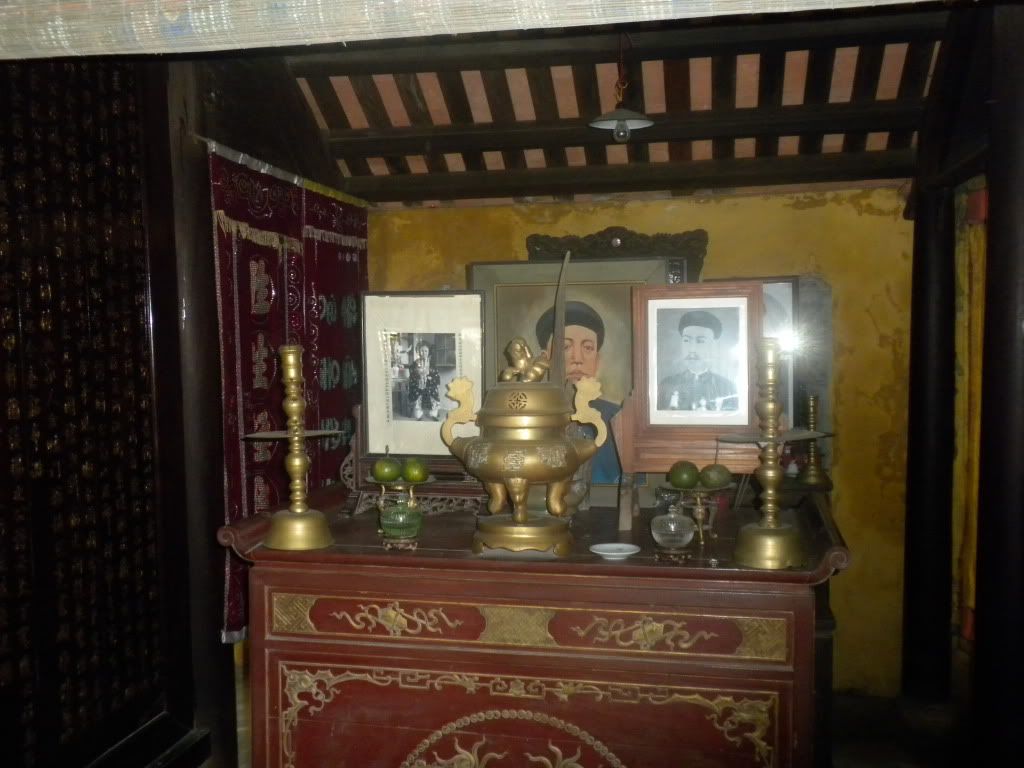
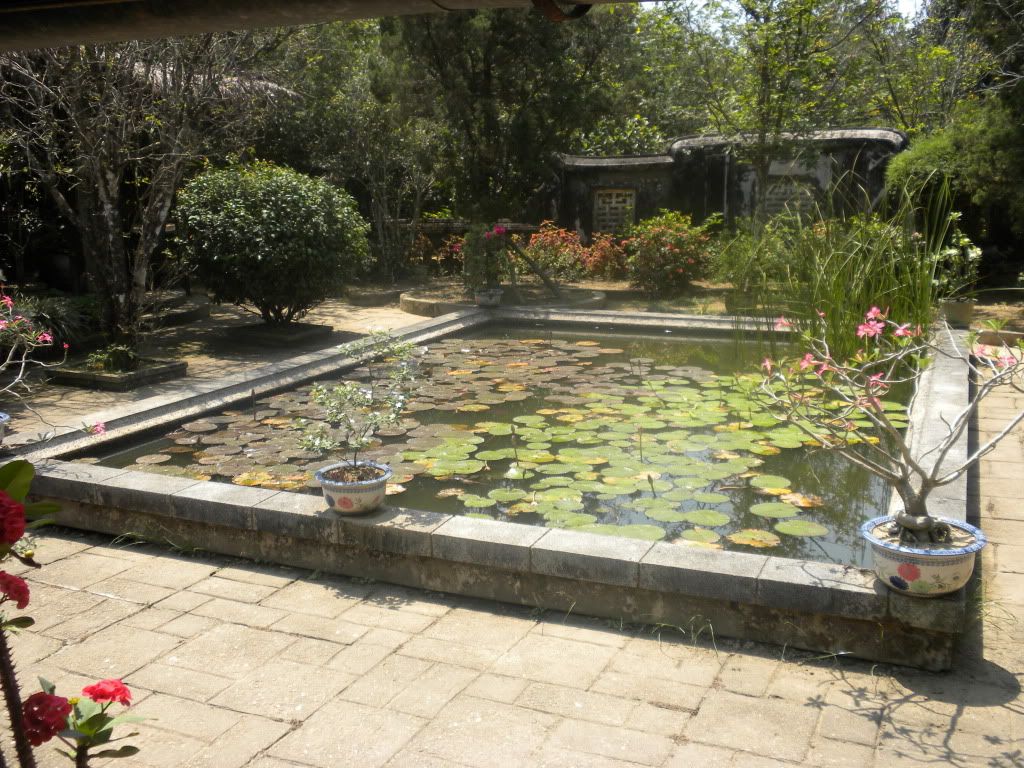
Next was the Thien Mu Pagoda, a complex of multiple buildings, the most impressive being the seven-tiered octagon-shaped Phuoc Dien Tower. According to sacred-destinations.com: “The Thien Mu Pagoda has its roots in a local legend: an old woman once appeared on the hill and said that a Lord would come and build a Buddhist pagoda for the country's prosperity. Hearing of this, Lord Nguyen Hoang ordered the construction of the pagoda of the "Heavenly Lady" (Thien Mu).” We looked around at the large guardian statues with real facial hair, the beautiful water views, and the graveyard towards the back. Henk and I walked around the complex, ended up catching the end of another tour group, as our group leader had let us all wander off on our own.
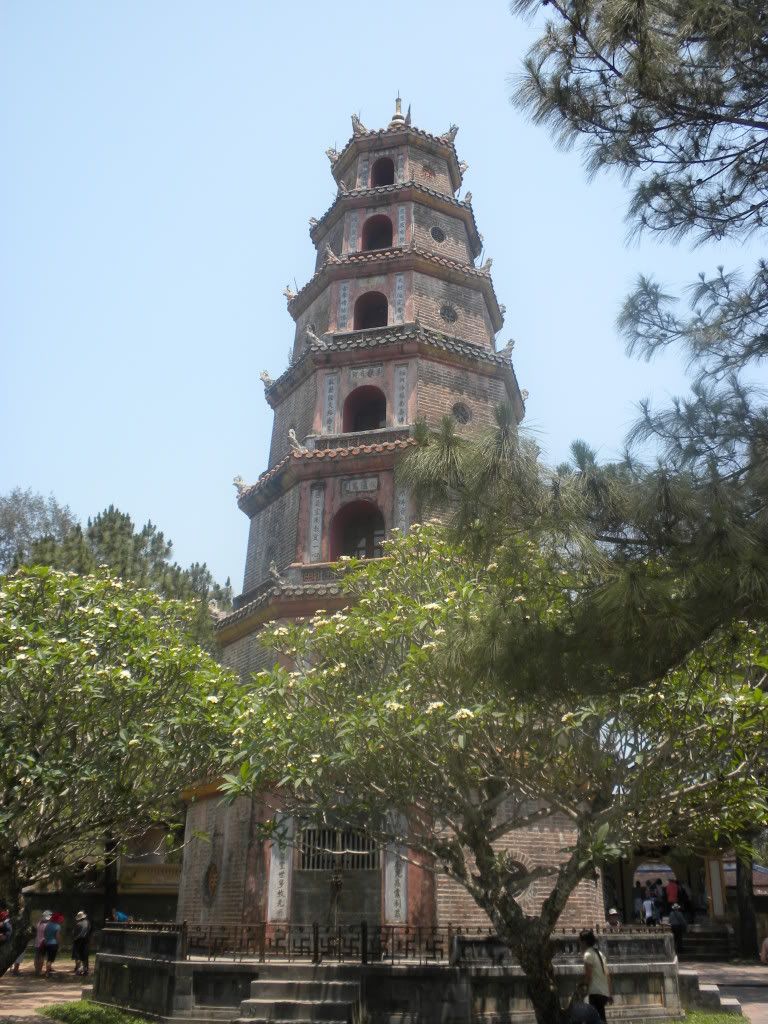
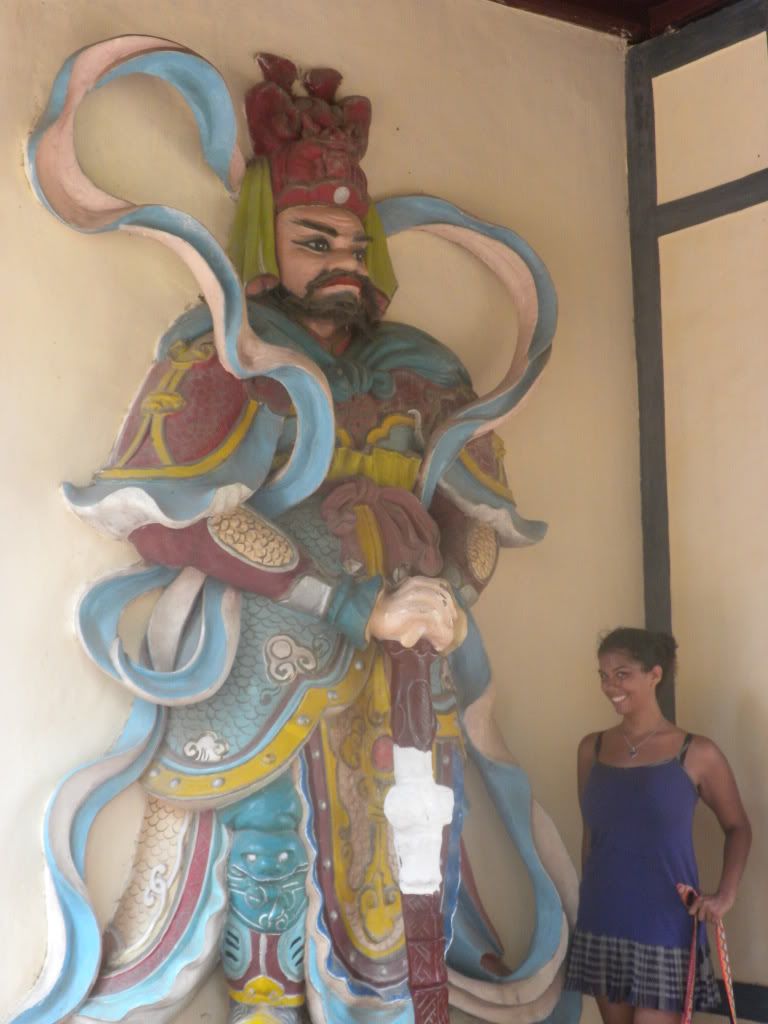
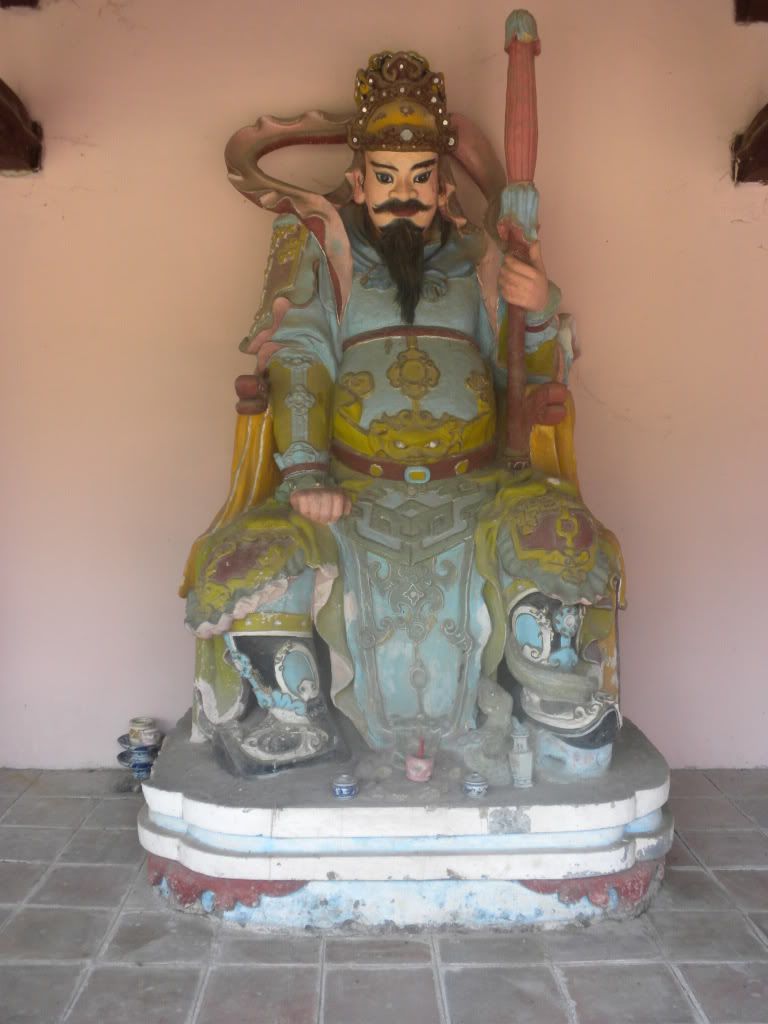
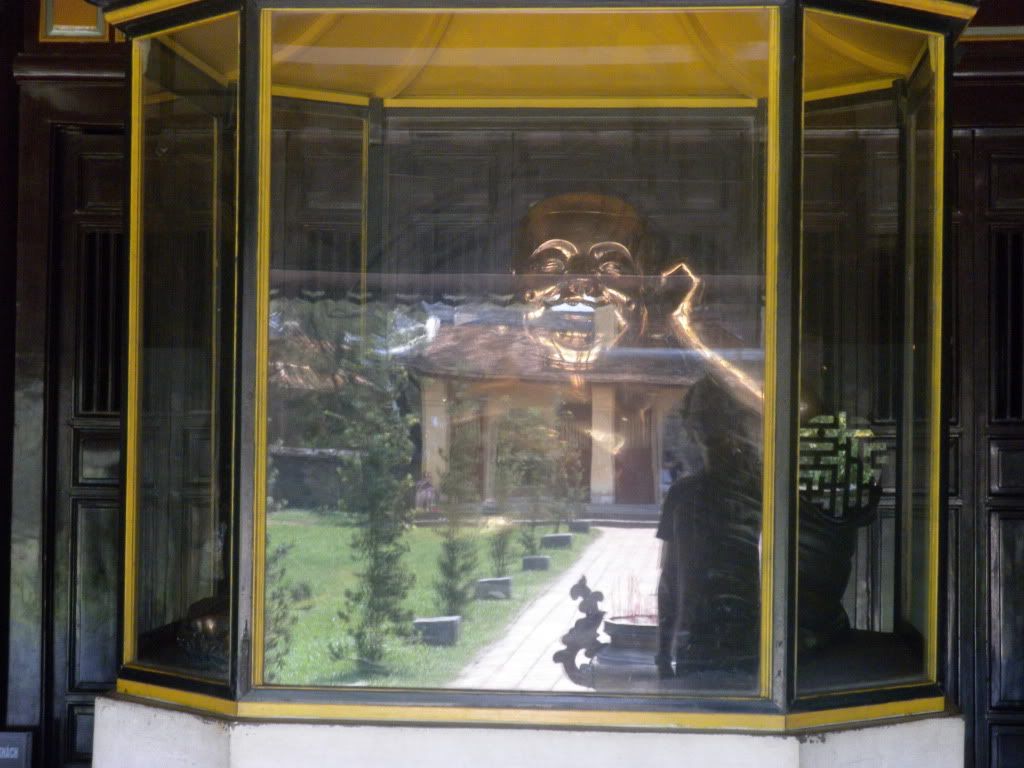
We heard this tour guide’s explanation of the car in front of us. This car, we learned, was that of Thich Quang Duc. I’m sure many of you are familiar with him without being aware of it. Below is the infamous photograph of his suicide. To the Wiki: “Thich Quang Duc was a Vietnamese Mahayana Buddhist monk who burned himself to death at a busy Saigon road intersection on 11 June 1963. (He) was protesting against the persecution of Buddhists by South Vietnam's Ngo Dinh Diem administration.” The car we were currently standing in front of is the car from the picture; the very car he drove to the scene.
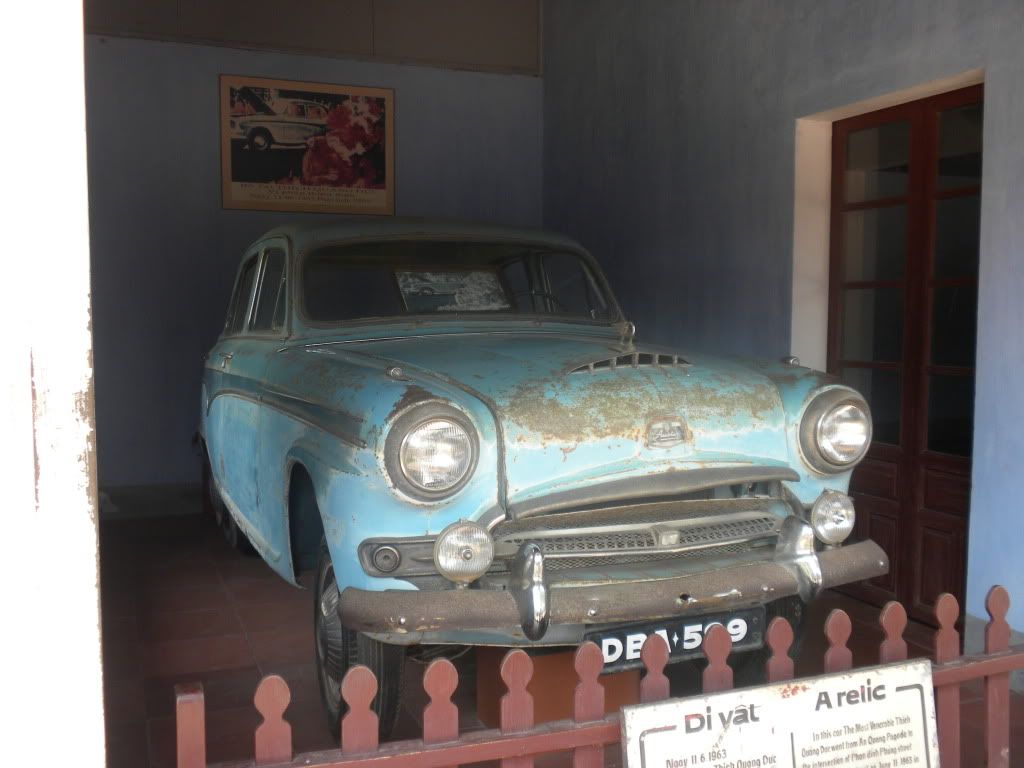
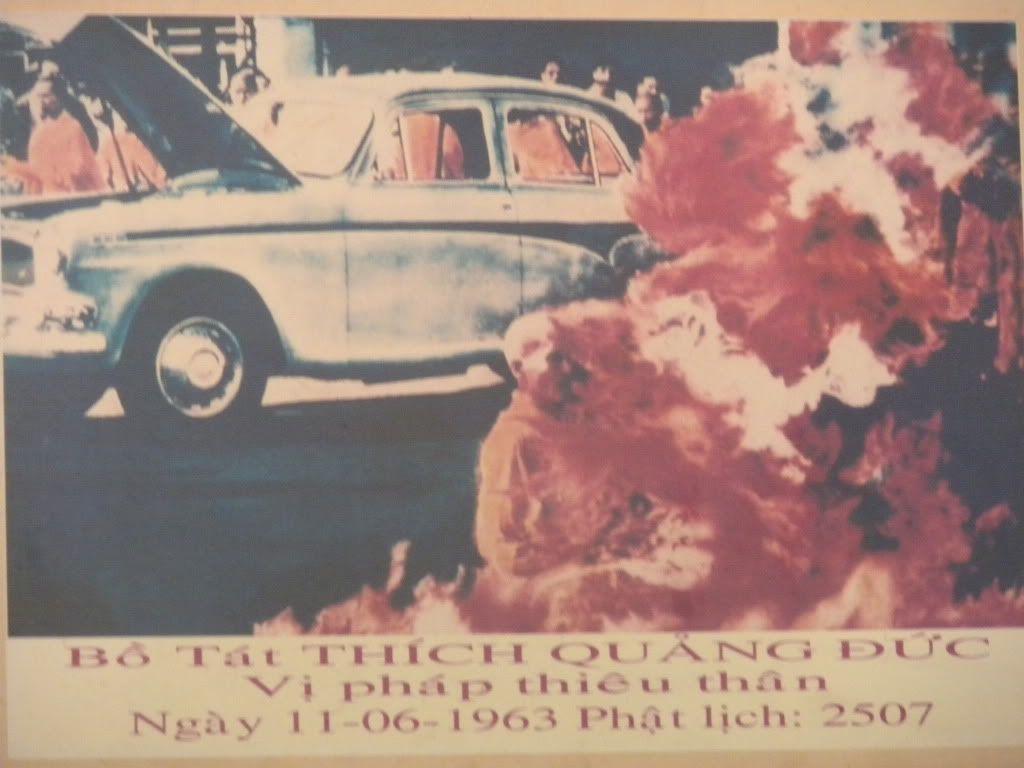
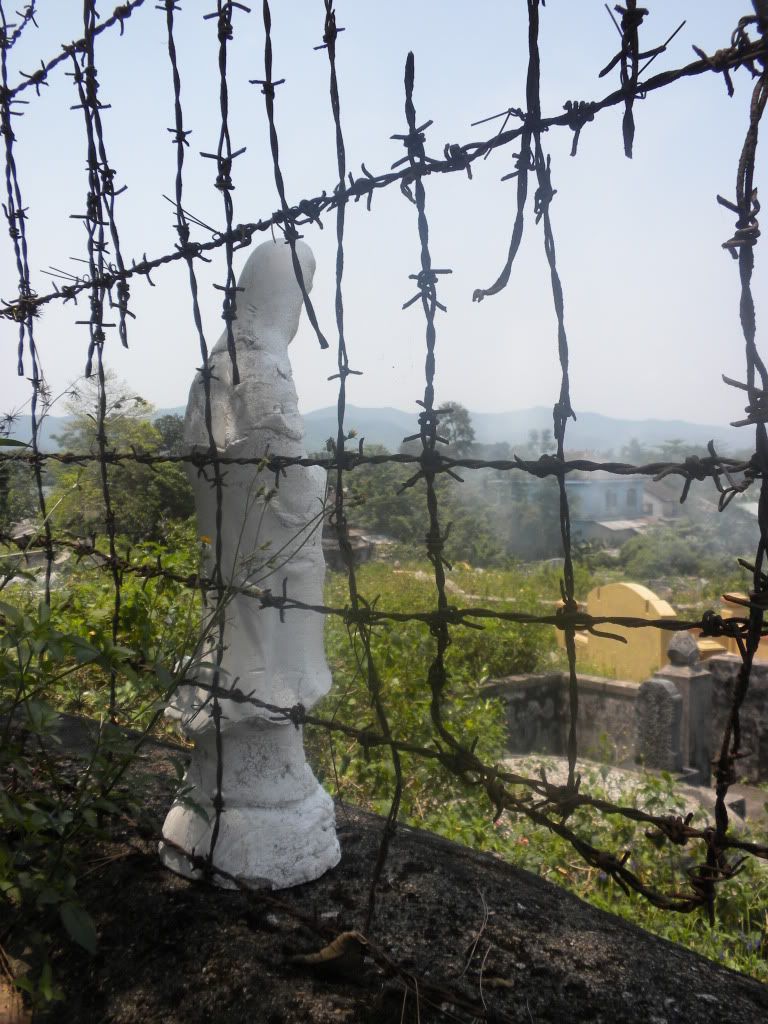
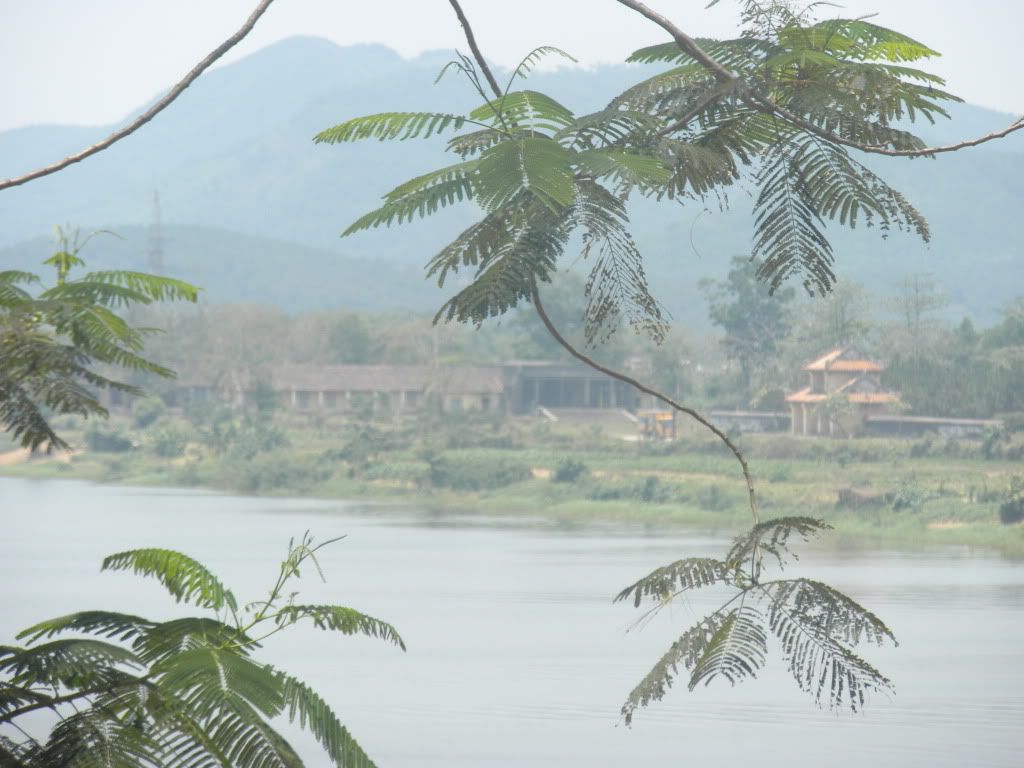
By now it was nearly noon and we were getting hungry. Thankfully our lunch stop at the ‘Stop-and-Go’ café was scheduled next and we dined on a buffet of local Vietnamese food while chatting with a Vietnamese couple visiting from Australia. Left on our day trip of Hue city was our visit to the tombs. There are three possible tombs to see, but since the entrance is rather expensive (and the tombs large) most people end up seeing just two. Our guide recommended for us to see the more traditional tomb of Emperor Minh Mang and for a contrast the more modern, Western-inspired tomb of Emperor Khai Dinh.
First we explored the traditional tomb of Emperor Minh Mang. Reigning during the early 1800’s, Minh Mang was: (go, Wiki!) “…well known for his opposition to French involvement in Vietnam and his rigid Confucian orthodoxy. As Gia Long aged, he took on a more isolationist foreign policy, and as a result favored Minh Mang especially for his outlook. Minh Mang was a classicist who was regarded as one of Vietnam's most scholarly monarchs. He was known as a poet and was regarded as an emperor who cared sincerely about his country and paid great attention to its rule, to the extent of micromanaging certain policies.”
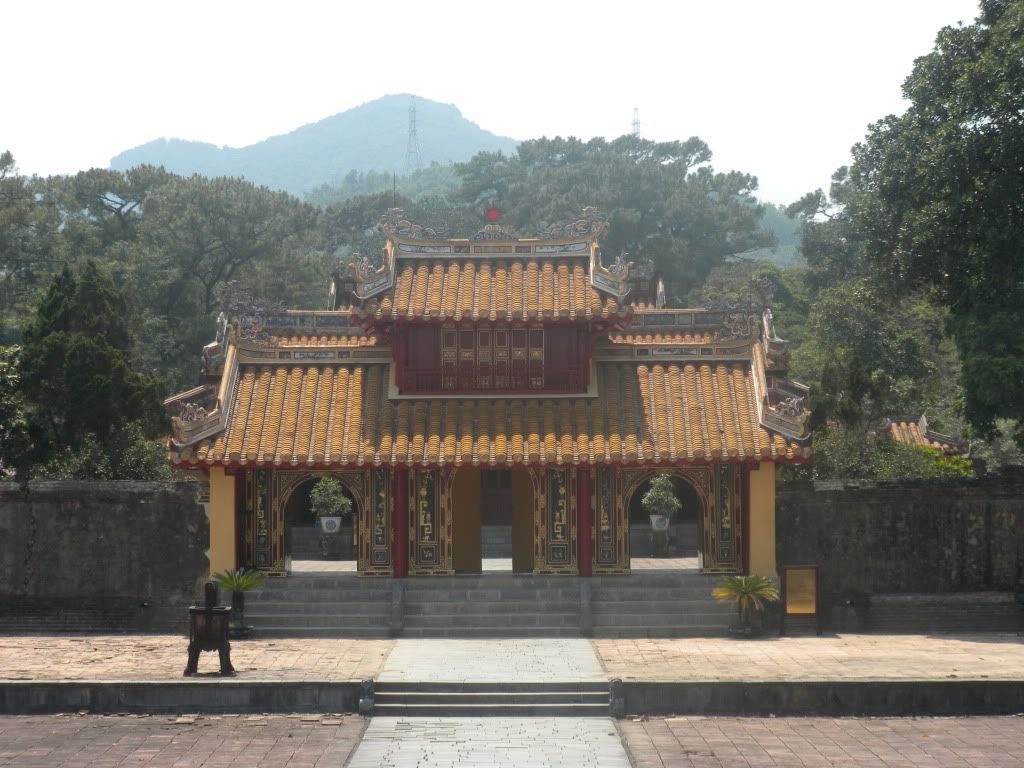
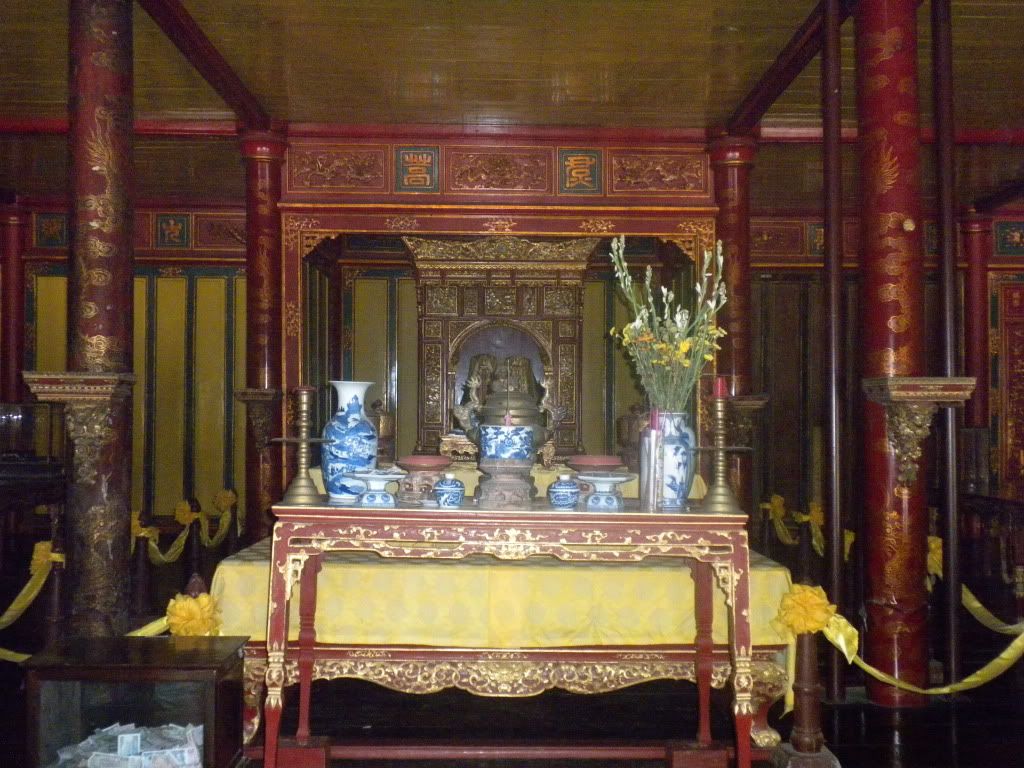
Minh Mang’s tomb has three gated entrances, the middle of course for his personal use. This central gate was known as the Hien Duc Gate, with the three-gated design typifying the aesthetic of the Nguyen Dynasty. There were right and left buildings for housing concubines towards the back of the tomb. The front of the tomb has a salutation court with stone statues of mandarins lining it. We had a bit of fun posing with these mandarins!
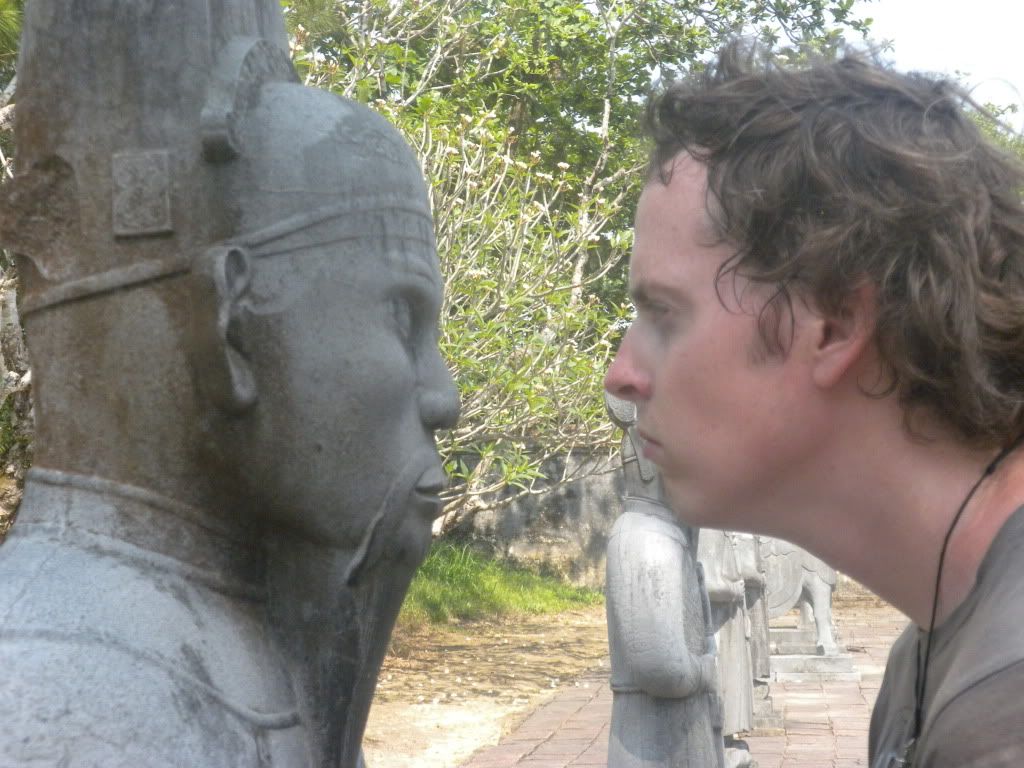
After getting our dose of traditional, we were ready for something that would really ‘Wow’ us. Emperor Khai Dinh’s tomb quite impressively filled this task. Dark yet beautifully ornate, the tomb combines Vietnamese and European elements. It uses eclectic fragments of ceramics and glass to form mosaics on the tomb’s walls. Despite the beauty of his tomb, Khai Dinh was not popular with the Vietnamese people at all. The Emperor reigned in the early 1900’s for just 9 years and was considered by many (including Ho Chi Minh) to be a puppet of the French government, attempting to legitimize their policies to his people in order to live a life of luxury himself. Khai Dinh eventually became a drug addict and died of tuberculosis in the Forbidden Purple City in 1925.
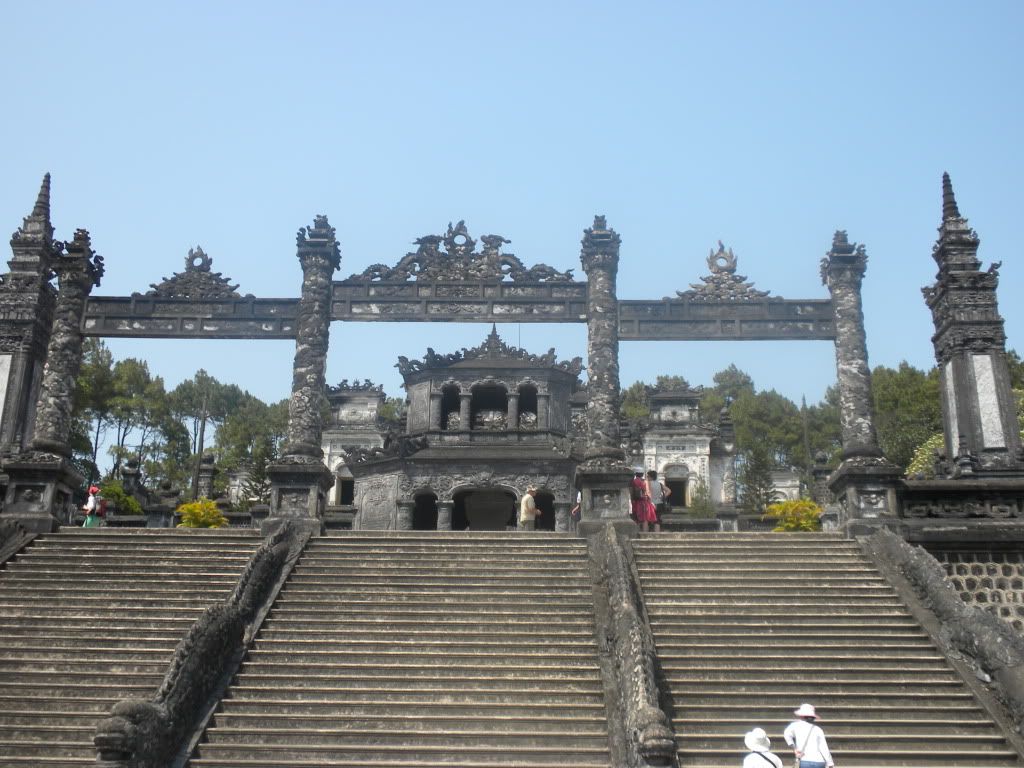
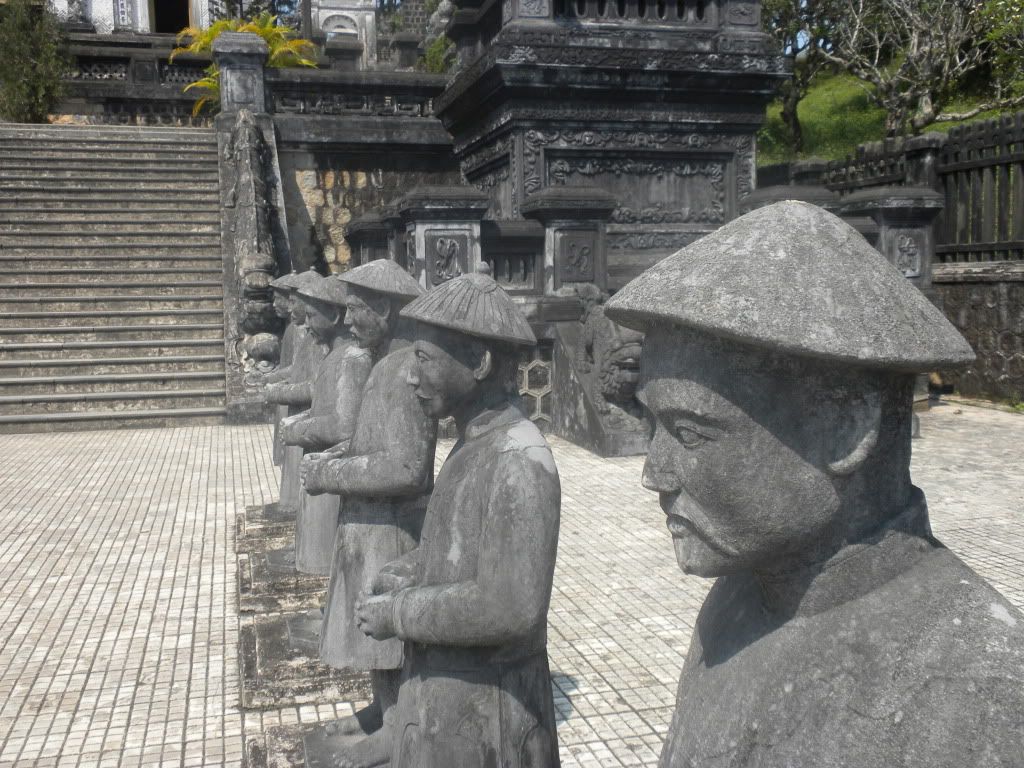
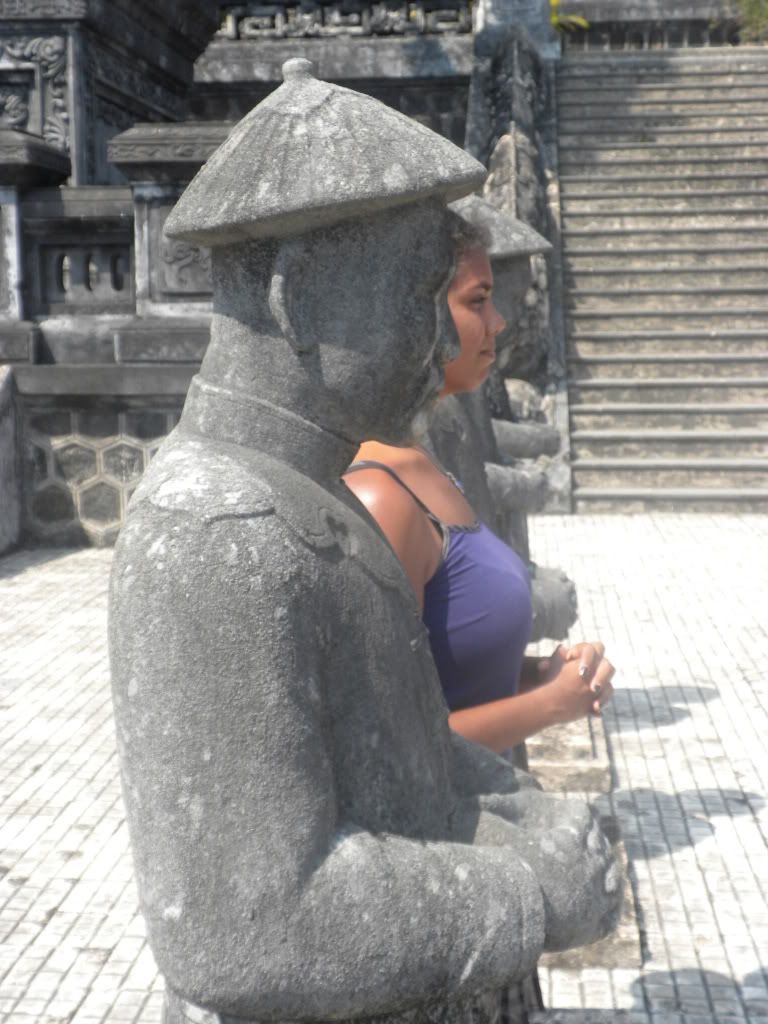
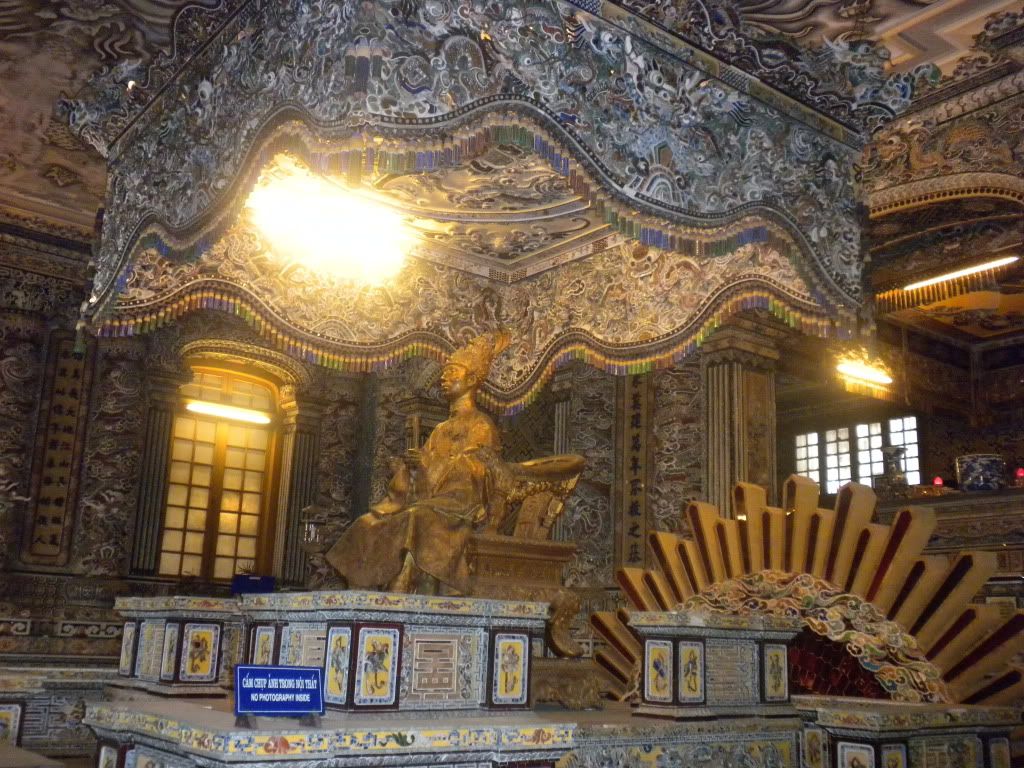
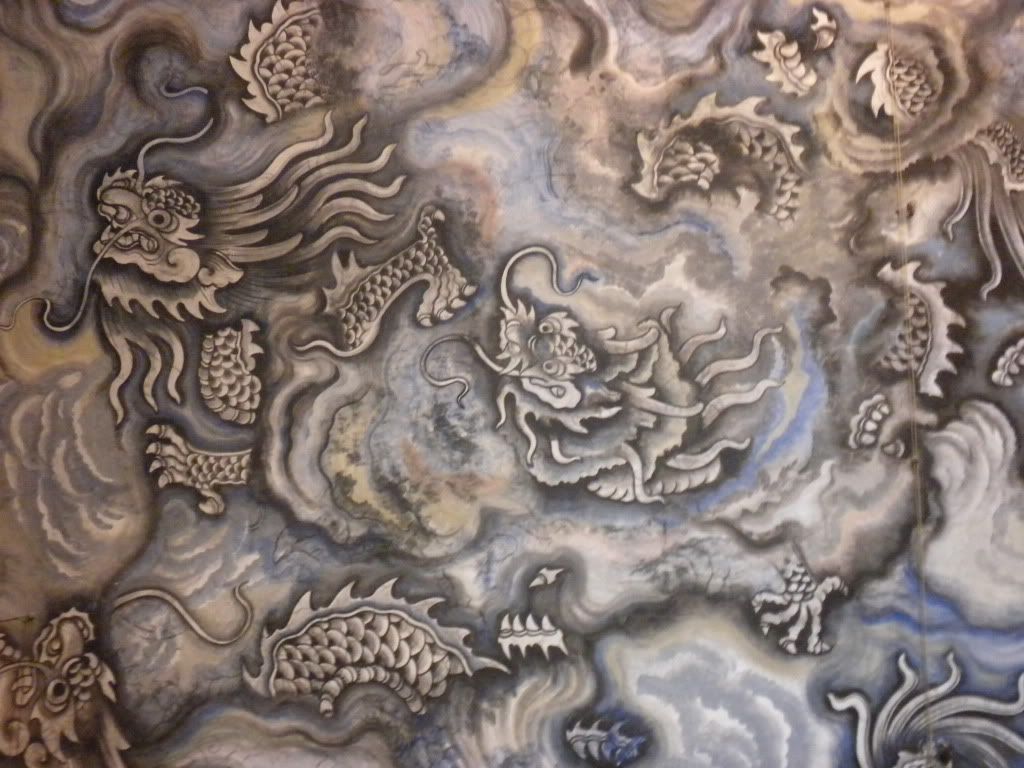
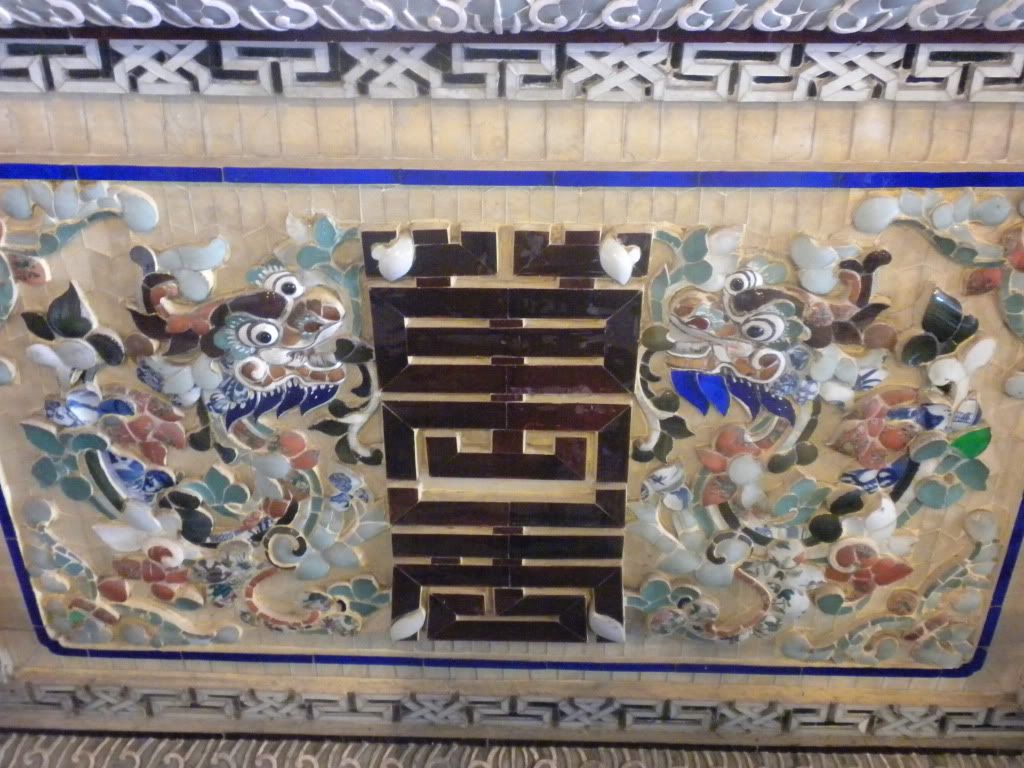
Now the tour was almost complete. The final thing on our agenda was the trip back to Hue via a boat on the perfume river. Henk and I watched the scenes around us on our return, but we also became interested in a black cat onboard the boat with us. Henk dangled the strap from our camera in front of it and we watched it go crazy trying to grab the end! Once we landed back on solid ground we headed home to our hotel, eager to get out of the heat that had been plaguing us all day. Later that evening Henk brought us some take-away and we watched some series after the long day.
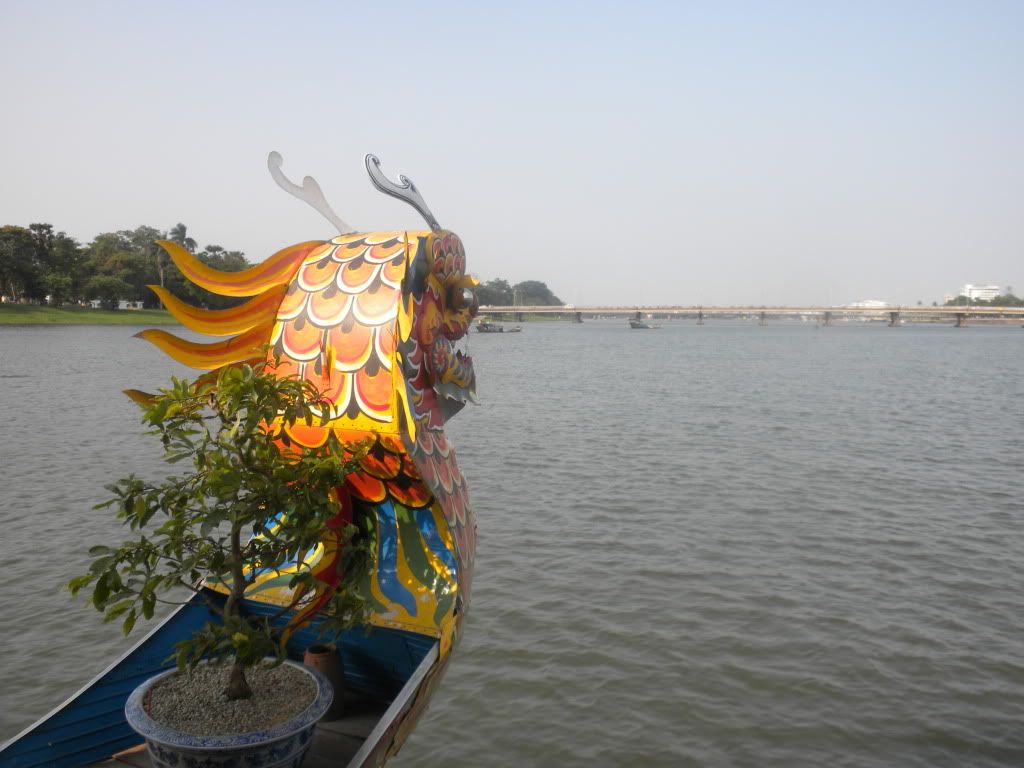
Tuesday, April 20, 2010
The Old Town Of Hoi An
Hoi An used to be a major international port in the 16th and 17th centuries, but nowadays it is a sleepy town. The heart of the city is still the Old Town, with its narrow, winding lanes and traditional Chinese-styled shop houses. After most of the original traders left their businesses to find their luck elsewhere the Old Town remained and a new trade took over: tailoring. The Hoi An of today is famous for the exorbitant amount of highly skilled and cheap tailors that can make you anything and everything you want for a very reasonable price. Luckily the Old Town became a World Heritage Site and is now a famous tourist attraction.
With a map in hand it took us about 5 to 10 minutes to make our way to the first streets of Old Town. We had gotten quite hungry and were ready for a good breakfast. Initially we had wanted to find one of the restaurants the Lonely Planet had mentioned, but we decided to just pop into the first decent-looking place we found. It turned out we made the right choice, because our shared tomato soup, my cao lau (a local noodle specialty) and Francesca’s chicken burger were pretty good!
We spent about half an hour navigating the Old Town, before wanting to enter one of the many historical houses. We found out we needed to purchase a ticket, so we headed over to ticket booth. The kind lady told us we had to purchase a 5-coupons-ticket, which could be used for 5 of the 15 attractions. Coupons in hand, Francesca and I went back to the Tan Ky House. After reading a little about the history of the house we were asked where we were from, got a small cup of green tea and received a short tour through the house. The old lady explained that her ancestors 7 generations ago traded in agricultural products, back in the 18th century. They had built the Tan Ky House with Japanese and Chinese influence due to close relations they had with traders from these nations. The lady explained the the crab shell-shaped ceiling supported by three beams in the living room was typically Japanese; Chinese poems written in mother-of-pearl hanging from a number of the columns that hold up the roof are a sign of the Chinese architecture. Francesca and I were arguably much more impressed by the kitchen area. Here the lady showed us water levels chalked on the wall from past floods. Some of them had reached heights over 2 meters! The old lady then left us to our own devices, and we continued exploring town.
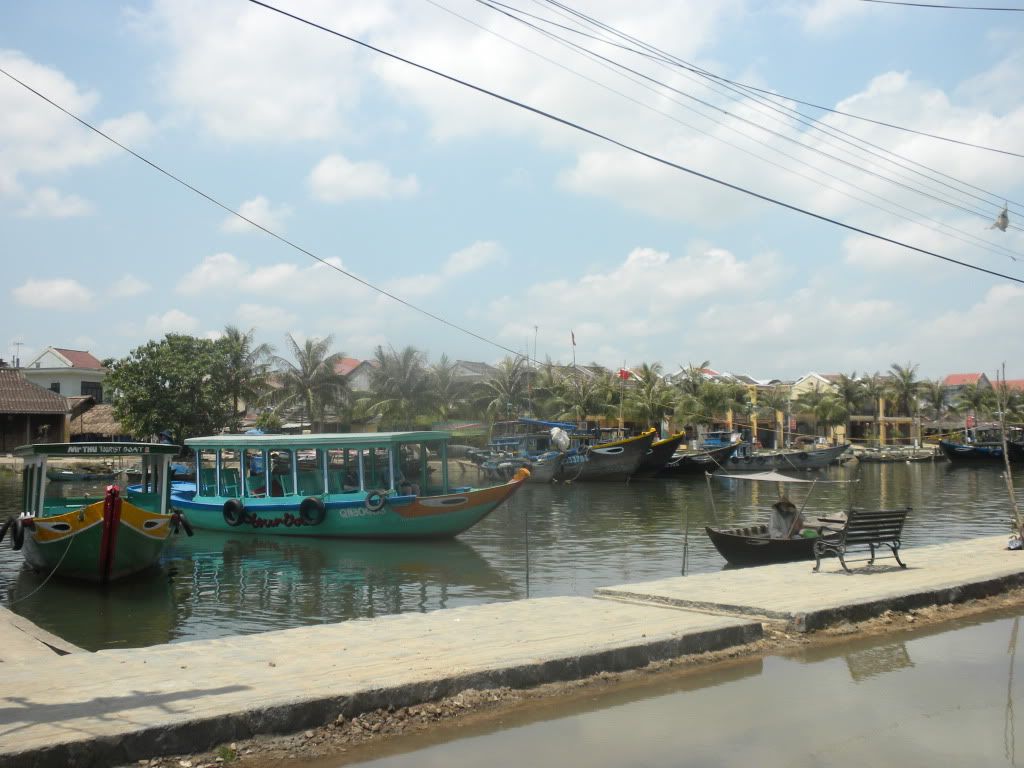
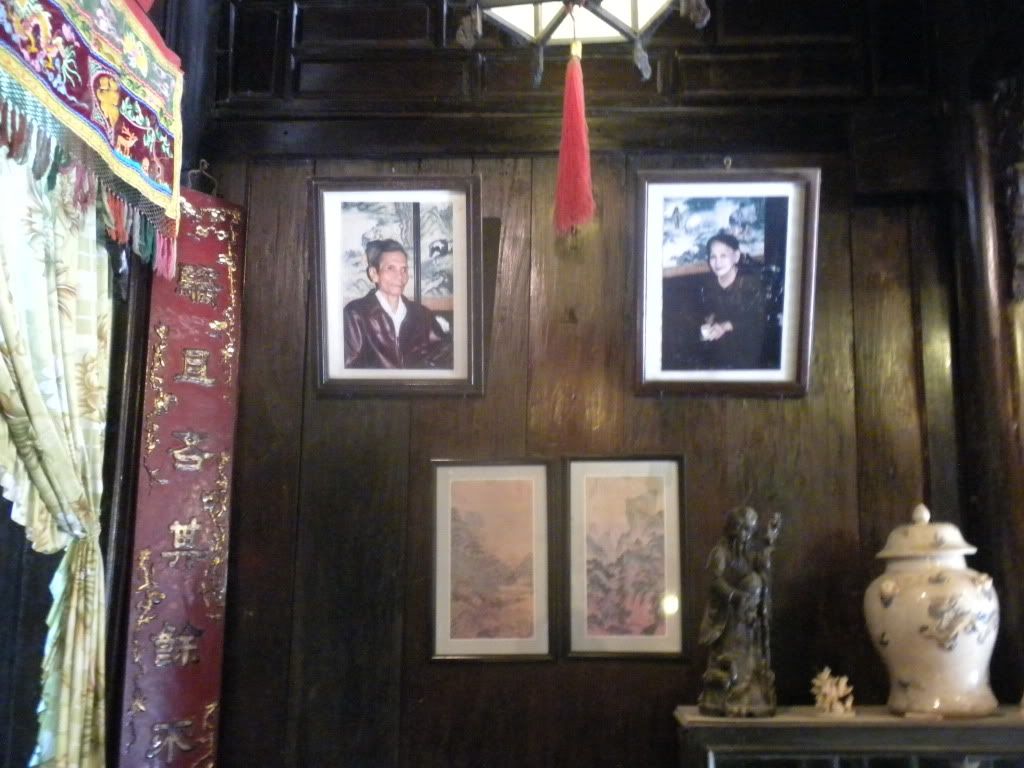
Francesca and I followed our map to the next destination: the Japanese Covered Bridge. This bridge was constructed in the early 1600's by the Japanese community to do business with the locals. The two entrances of the bridge are guarded by a pair of monkey gods at one end and a pair of dog gods on the other end. There’s also a small temple inside the bridge, which Francesca and I entered. There wasn’t much to see, which meant we crossed the bridge and continued walking. We passed another historical house, but skipped it, preferring to admire the picturesque streets.
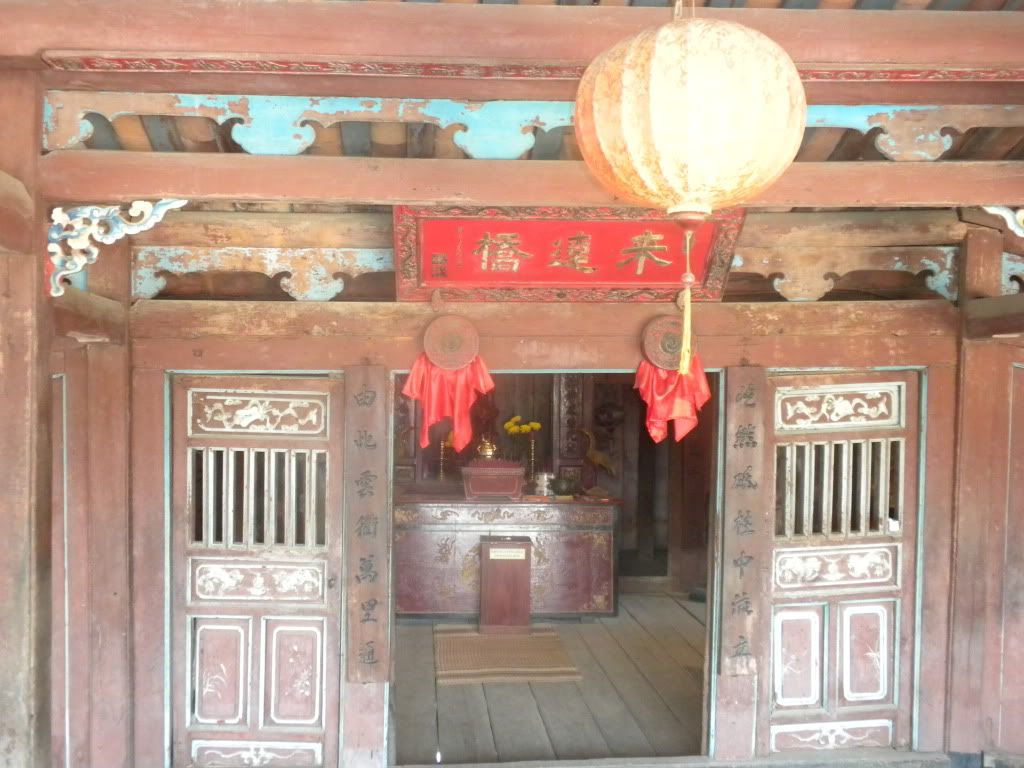
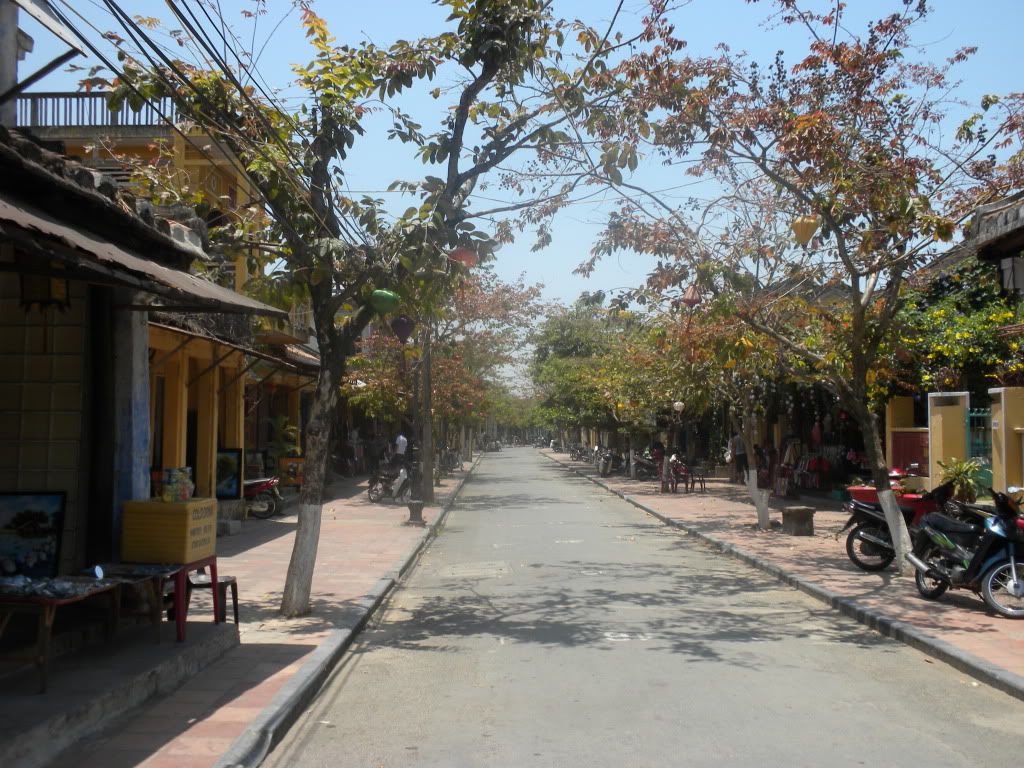
My flip-flops had been falling apart for some time now, which prompted us to finally look for a new pair. We could’ve had some custom-made, but in one of the many shoe stores we found a good, comfy, sturdy-looking pair to replace my old ones. Best thing: they only cost 2 bucks! New footwear in use we continued our walk, whilst the afternoon sun became ever less friendly. Around 1:00 PM we walked past one of the many tailors and spotted a winter jacket with a cool design. We asked how much it would cost and if we could change the fabric/design. A keen nod followed and Francesca and I perused the different shades of purple (obviously!). There was nothing to her liking, but that didn’t deter the shop owner. She grabbed a helmet, gave it to Francesca and the two of them raced off to their workplace. About a quarter of an hour later they came back, Francesca with 3 options in hand. I found a favorite in a black, purple and white striped fabric. For 30 dollars Francesca would have her own, form-fitted jacket… What to do?! Do we need a jacket now? Perhaps we can use the money for something better. Not an easy choice! We postponed the decision and told the ladies we’d be back if we wanted the jacket.
The afternoon was spent back at the hotel, where we started feeling the combination of the sleeper bus and sun in our weary bodies. We watched a bunch of Simpsons and got a tiny bit of sleep. On a normal day that would’ve been the end for us. We would’ve stayed in, ordered food and watched a movie. Today however, was a different day. We wanted to see a cultural performance in the Old Town, and had to put our flip-flops on once more. When we arrived at the Hoi An Artcraft Manufacturing Workshop around 7:00 PM it turned out we were the only ones there. Since we were a little early, and the performers a little late, Francesca and I had a look inside the workshop first. We really liked some of the paintings, and found an interesting new sort of carving done with bamboo roots. Around 7:30 PM our show started and we were still the only ones!
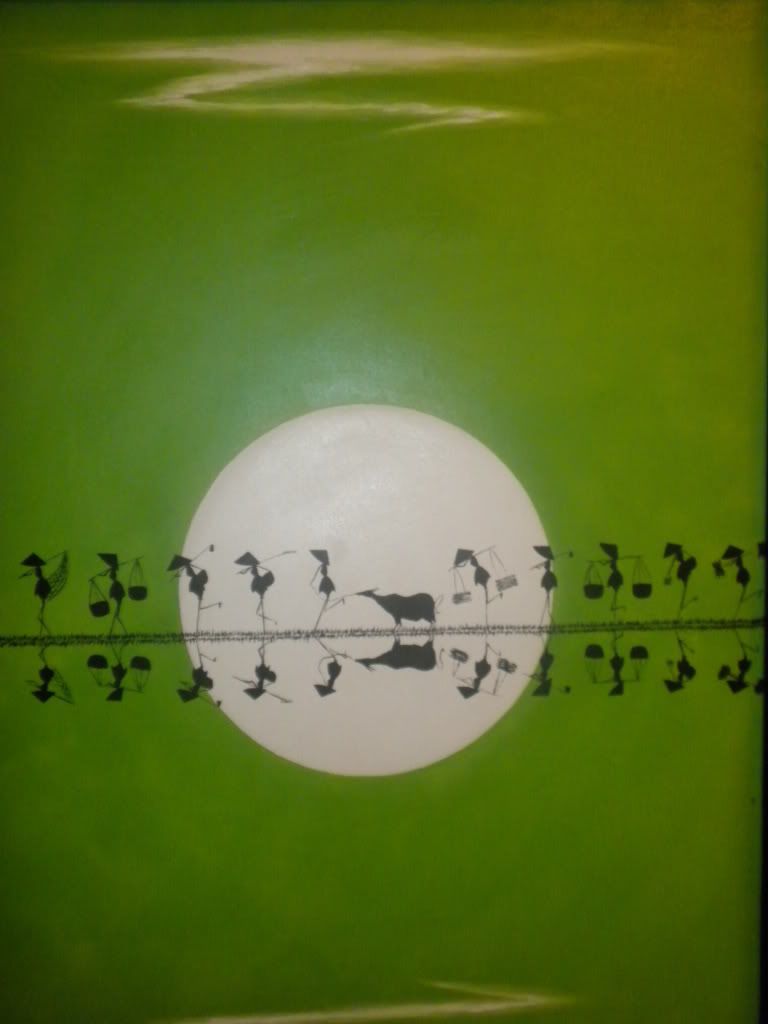
First we got a good listen to 5 performers playing different local instruments. A group of 5 dancers joined in not long after, and continued for a good 30 minutes. The interludes were amusing as the lady introducing the new songs still talked about ‘LADIES AND GENTLEMEN!’ when we were really the only two onlookers. We guess they’ve just rehearsed those few lines to death and can’t change. Anyway, we got to see a few different dances and some solo performances, which made for a pretty cool show. It being 8:00 PM by now and the two of us not having eaten for nearly 12 hours told us we needed to eat badly. And what better way to satisfy your appetite than by eating Indian? We went to Sree Ganesh, one of the Indian places in town and found, to our disappointment, that all the tables were taken. Gnawing on a stick we waited, and after 10 minutes a table became available. Butter chicken and chicken sagwala with our favorite naans soon followed. Oh, how true it is that food tastes better when you’re really hungry!
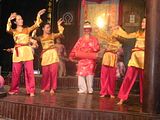
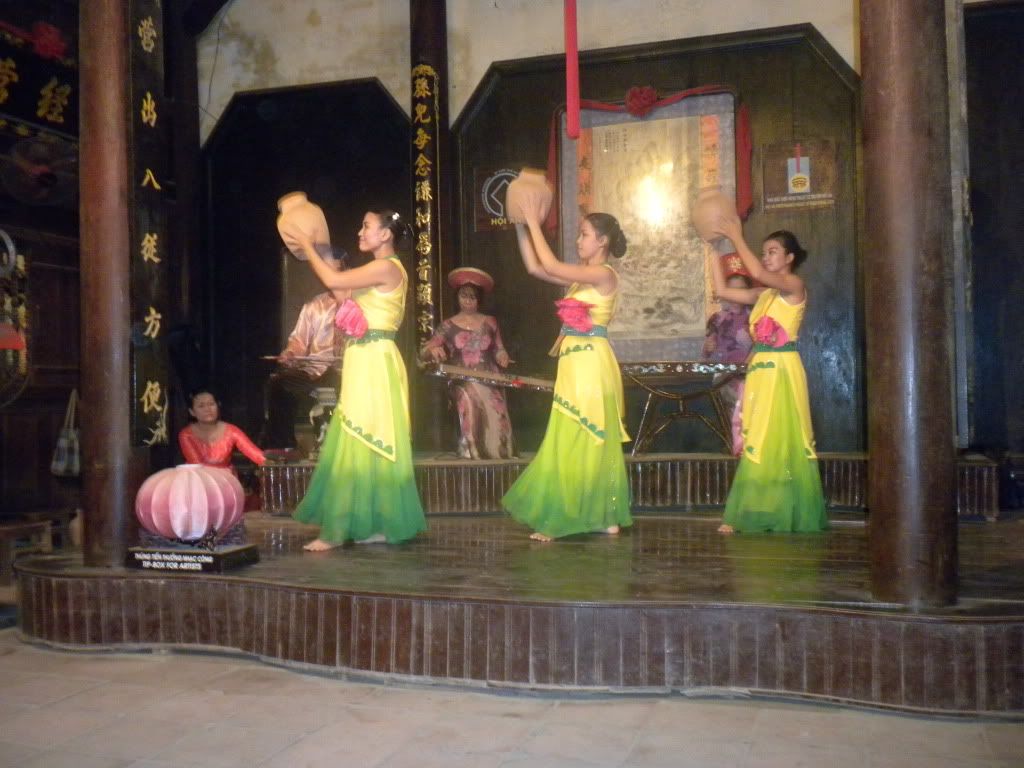
On the 19th Francesca and I awoke around 8:00 AM. Before seeing the show last night we had paid a visit to Mr. Phong, a local man who came highly recommended by several online sources. He told us about a tour that would take us to his home village, where we would get a serious cultural and history lesson, as well as a visit to some local sights. To top it off a home-made lunch would be included. We said yes and were picked up just outside our hotel around 9:00 AM. Francesca hesitantly jumped on the back of Mr. Phong’s motorbike, whilst I joined Mr. Khong on his motorized steed. The scenic drive to Mr. Phong’s village was already well worth it. He had us stop by the side of the road to watch farmers harvest rice. After about half an hour we arrived at Mr. Phong’s village and house and sat down with him. Our first real history lesson was about to start!
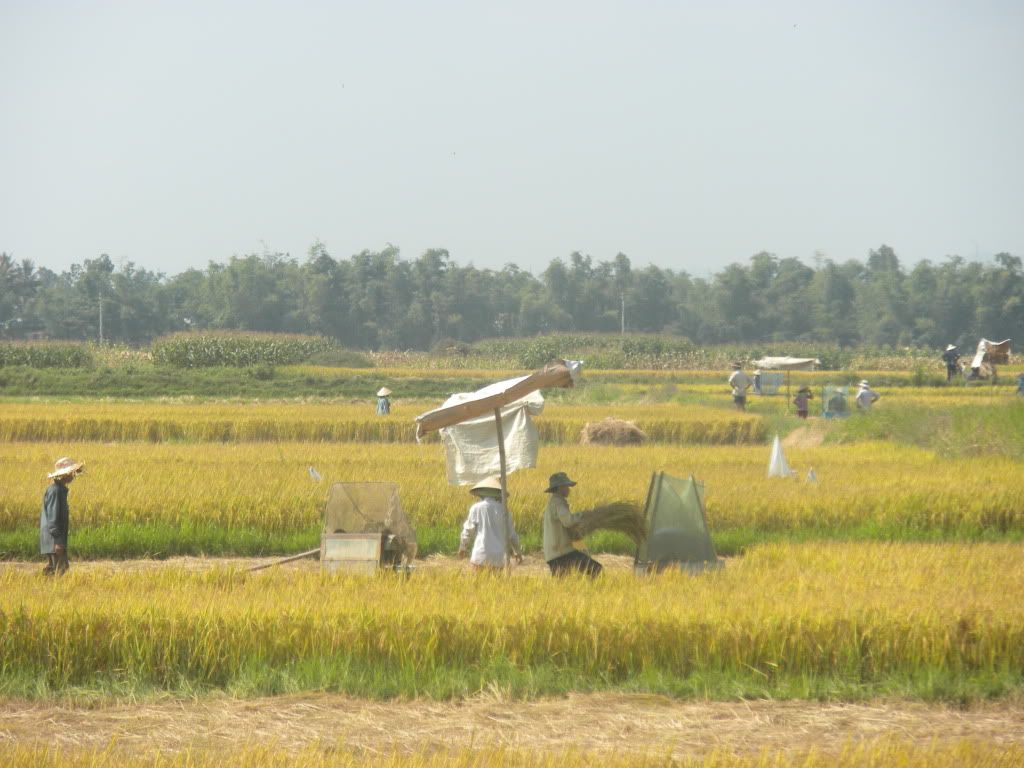
With a cup of tea in hand Mr. Phong began his stories. He grabbed a piece of paper and drew a map of Vietnam. He showed us where the DeMilitarized Zone was, how the country had been divided and where the important cities of the time were. He shared how he had fought for the South and how hard life had been. We learned that the Communists, after Vietnam had been divided into North and South, left about 10% of their people in the South, where that group formed the South Vietnamese Liberation Front. Very sneaky, because they were really just Communists working for the same party. Or, as Mr. Phong said: Same same, but different!
Mr. Phong then related to us about the ending of the war, and how the struggle for the South Vietnamese continued after the Americans left. He told us how the Communists implemented a point and coupon system for the laborers. Each person had to work, either on the fields or as a doctor, teacher etc. With the work they did they earned points, and the points were then converted to coupons for rice, meat and some money. Doctors would get more money, but less rice, since the farmers would need more food to sustain themselves. The problem, as Mr. Phong explained, lay in the shared work: nobody went out of their way to earn a living, everything would be shared anyway. Furthermore, if people disliked you they could vote against you and give you fewer points. In the end, the problem was solved due to outside influences. Kissinger convinced the Chinese to open their market, whilst Vietnam’s strongest ally, the USSR, fell. The Vietnamese Communists also opened their market. On the other hand, they maintain their one-party-system and beat down on protesters hoping for a more democratic multi-party system.
Around 10:30 Mr. Phong invited us to have a look around his brother’s house. We got to see their Confucian family altar, where pictures of his father and mother peered back at us. Conveniently, the Communists don’t recognize Confucianism as a religion, because party-members aren’t allowed to follow any. Instead, they consider it a tradition. We found this very strange, because ancestor-worship, making merit and appeasing spirits are in many other cultures seen as a form of religion. He told us that usually the youngest son inherits the house, but since his kid brother had been disabled, he’d ended up getting their house. Mr. Phong told us about the tradition of burning fake money for the ghosts of those who died in the area. He added that they started burning fake dollars for the deceased Americans, because their ghosts wouldn’t recognize the fake Dong. Pretty amusing.
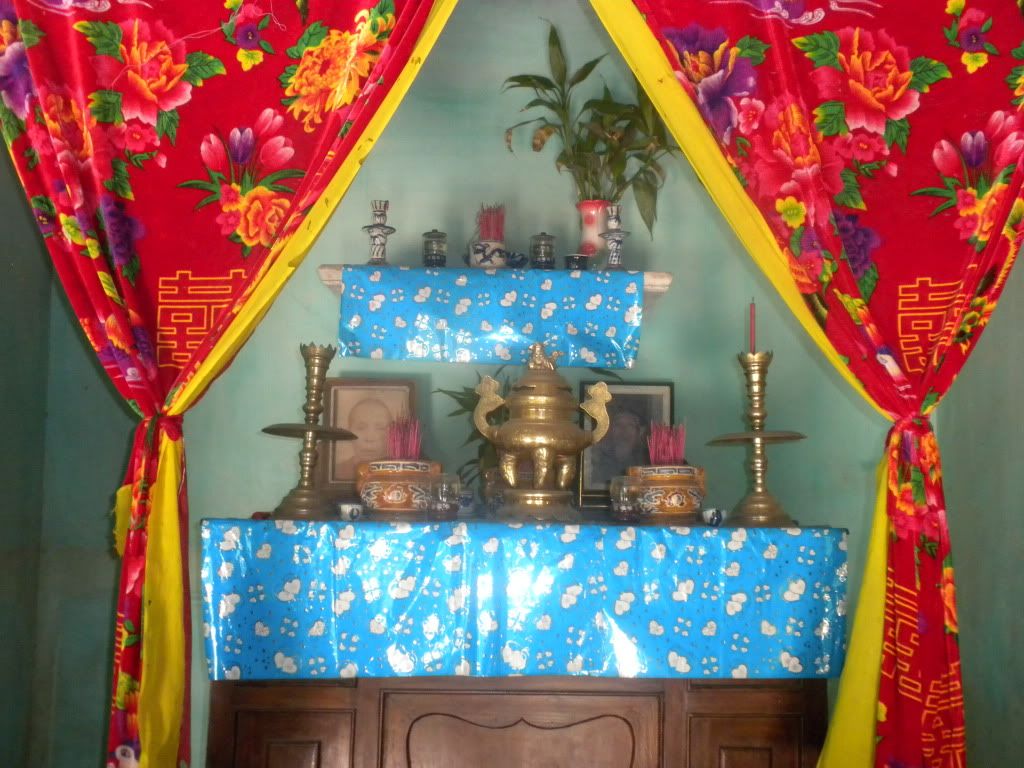
We also got to see his brother’s family’s kitchen, where small altars were dedicated to kitchen gods. Giant jars for storing rice lined the walls, and made us think back to the Plain of Jars, wondering if perhaps the storage theories had been right after all. Outside Francesca and I got a quick lesson in rice harvesting: an old barrel with spikes spins rapidly and when the rice makes contact with the wood the grains come out.
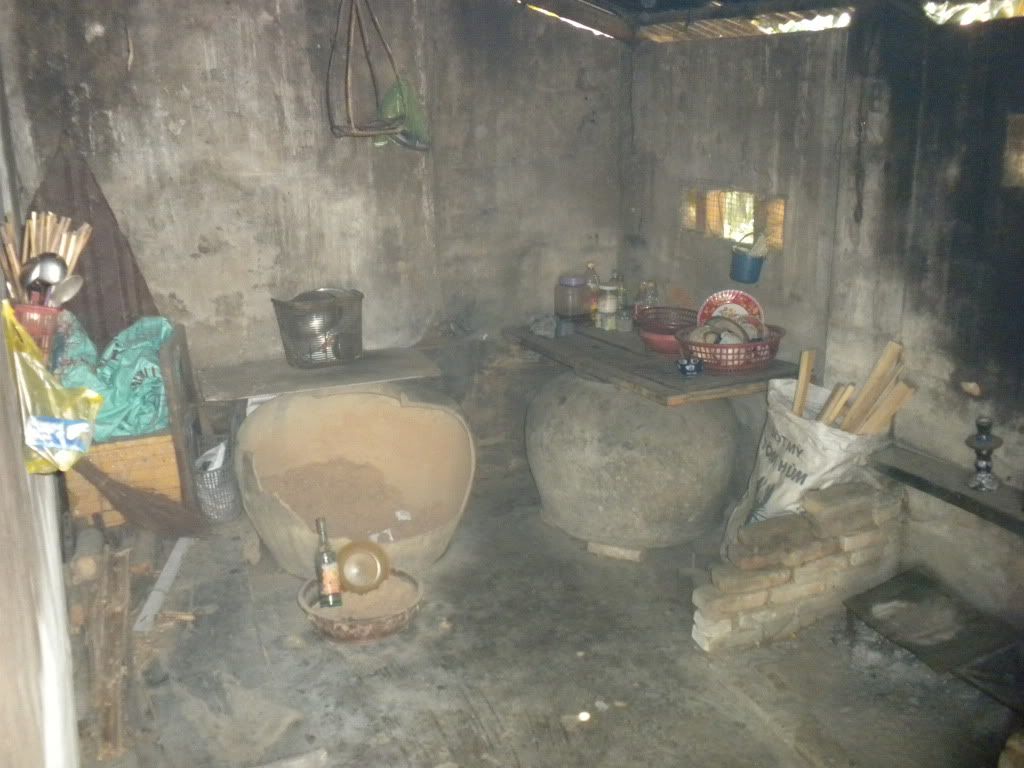
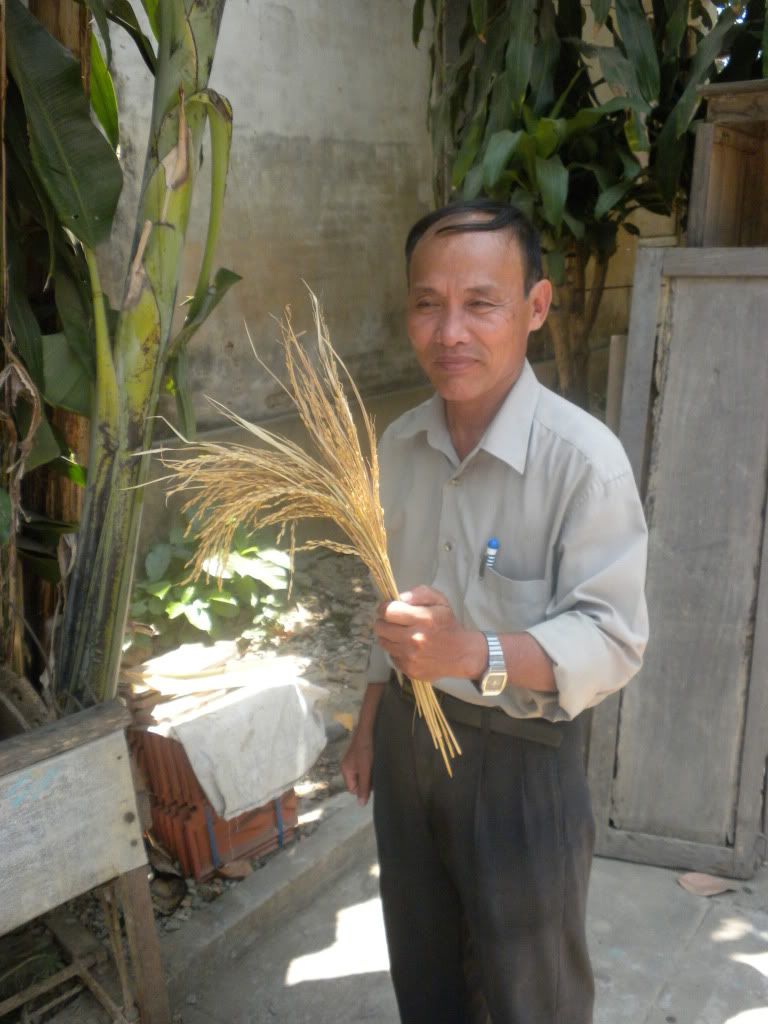
Mr. Phong took us to one of his friends, a rice wine maker. We got to see the rice fermenting, the fluid being tapped and that fluid being boiled to extract the alcohol. Very interesting to see how such basic methods still work so well. Mr. Phong led us outside, onwards to the river. Here we saw a bridge that had been destroyed by Americans during the war. Nearby was another, bigger bridge and the Vietnamese had sniped from the smaller one, killing some Americans. The Americans retaliated by blowing up the entire smaller bridge.
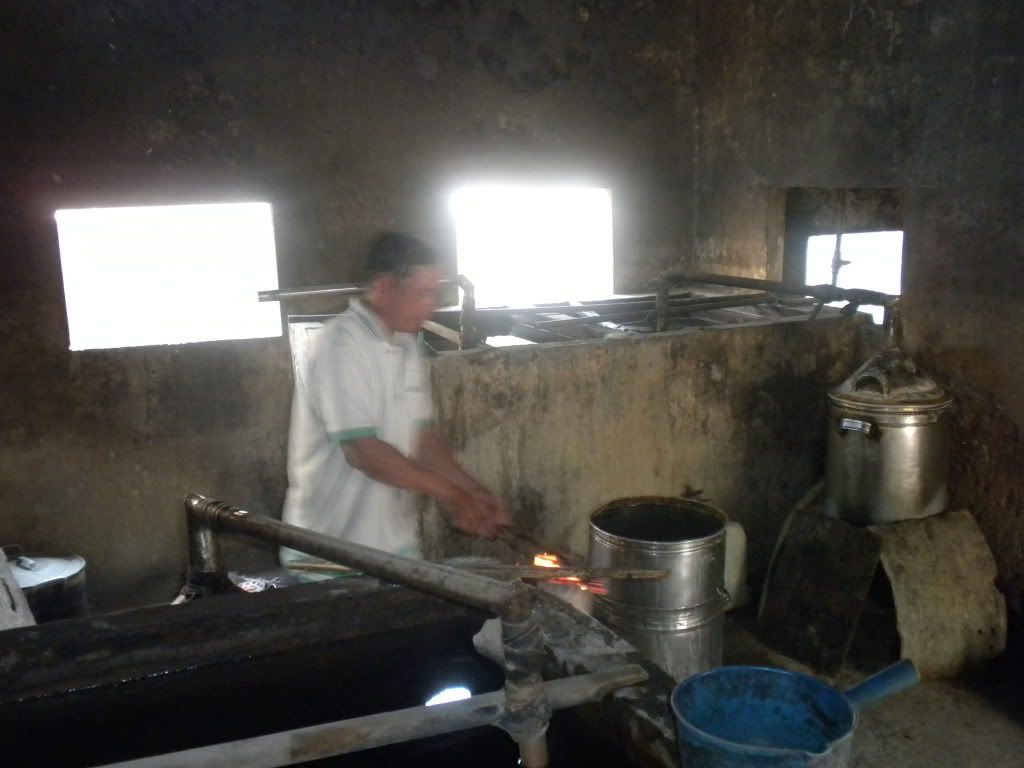
Francesca and I also got to see some of the main farming activities of the town. Whole porches were covered in corn, whilst others were drying crazy amounts of corn husks. We sat down with some old ladies who were preparing the fresh corn husk leaves for the drying process. After the leaves have been dried sufficiently the got sold to tobacco companies and used for cigars and cigarettes. They were all chewing betel nuts, which we hadn’t seen being done for a while. They smiled as Mr. Phong showed us some of the nuts.
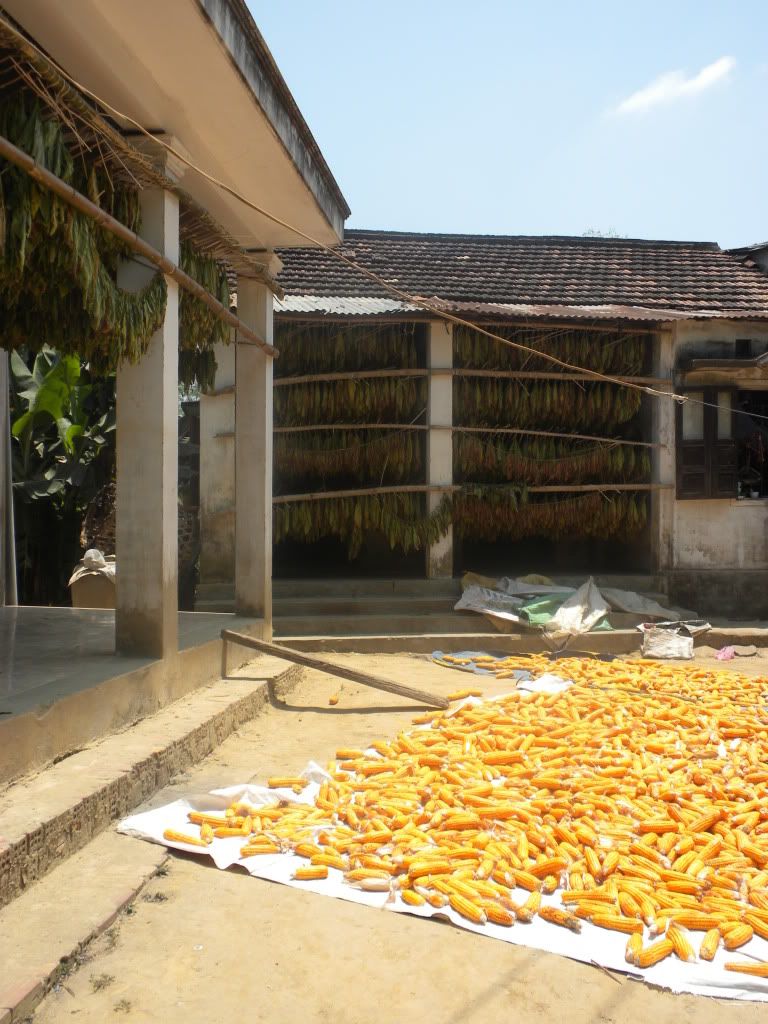
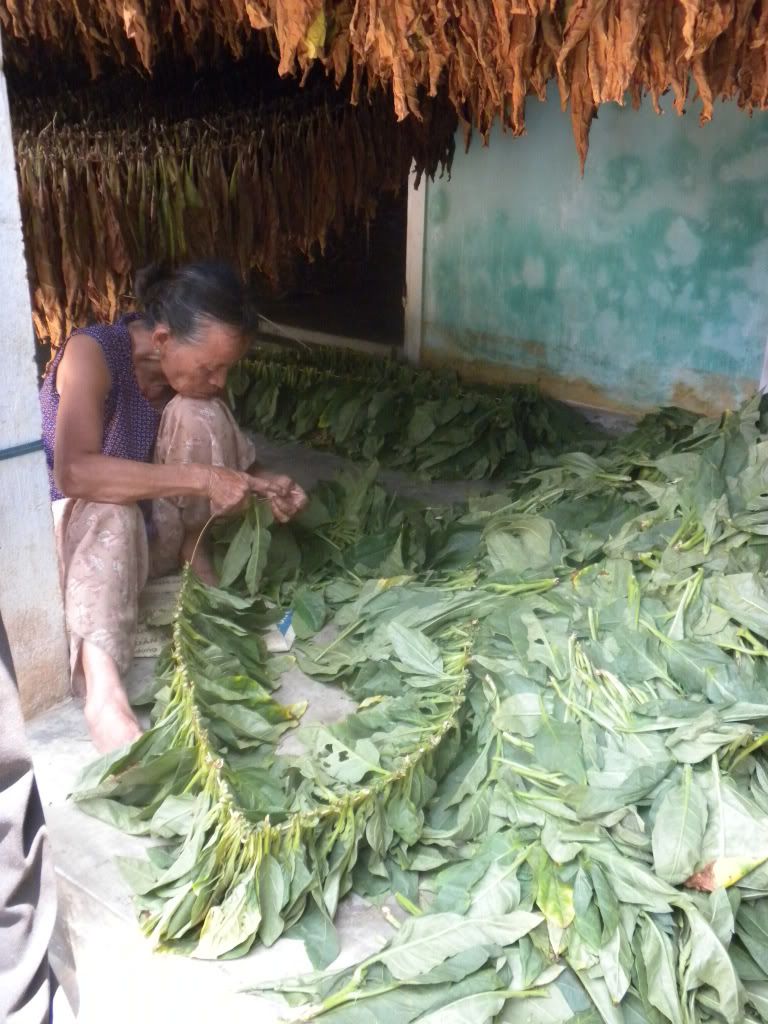
The market was up next, and we became more of an attraction than anything being sold. An old lady gave Francesca some betel nuts, we saw winter melons (which look like giant cucumbers!) and Mr. Phong showed us the packages of paper clothing and other gifts that are burned for their ancestors. Similar to the money, Confucians believe their ancestors still need new clothing; therefore they burn the gifts for them. Traditional Confucians also do not celebrate their birthday. Instead, they all age with Lunar New Year. They do celebrate death days, on which the extended family gathers at the family shrine, where they make offerings and tell stories about that person.
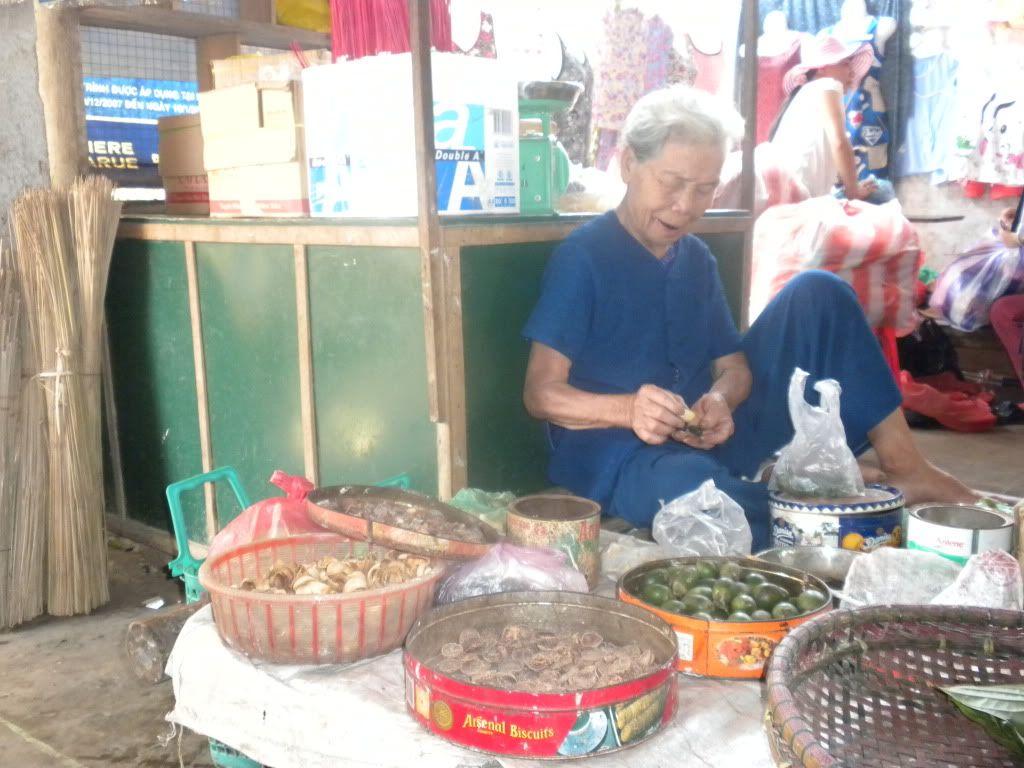
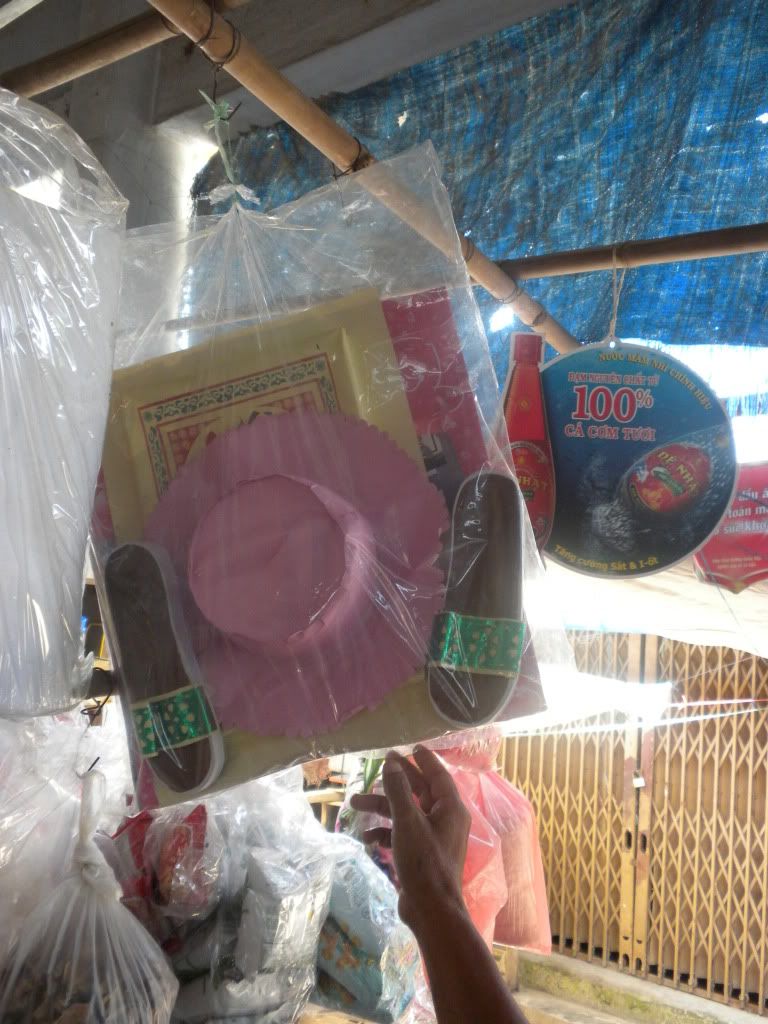
Francesca and I spotted a fruit we had seen before and wondered about. It was round, green and looked to have scales… What could it be? We asked Mr. Phong and he told us they were custard apples. Later that day I tried one: not so good! Our merry band left the market and crossed the street. We were greeted by some kids, who wanted to have their picture taken. I got Francesca to pose with them and showed them their picture afterwards.
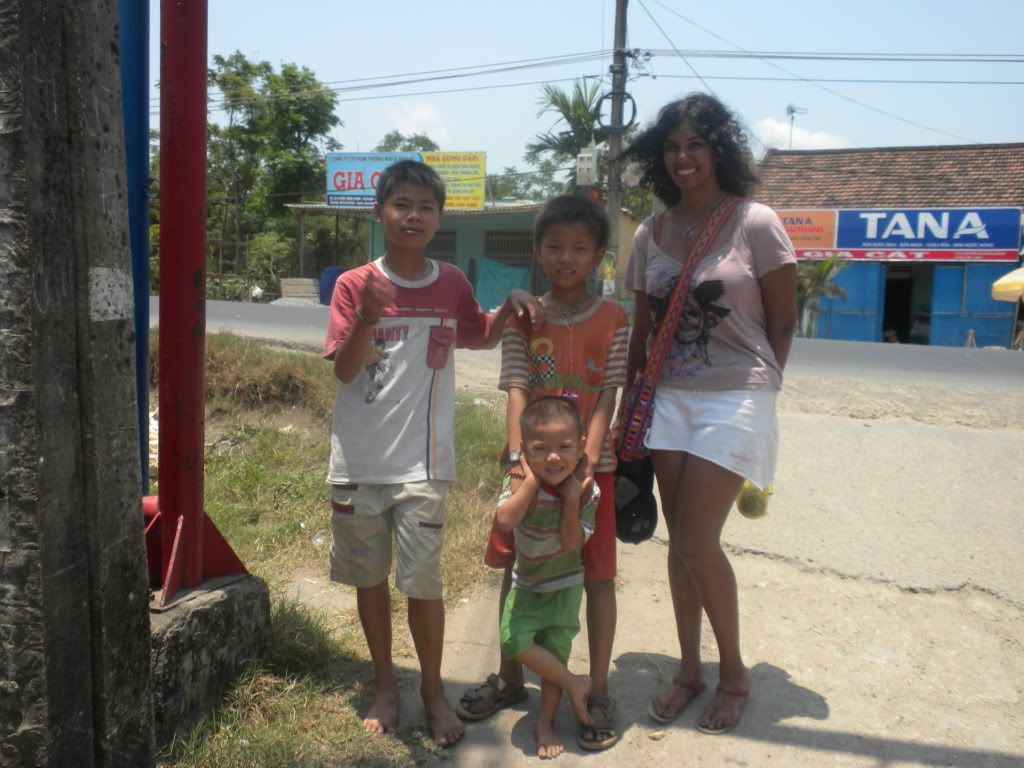
Mr. Phong showed us a Buddhist shrine, proving that some families do not care about the Communist rules, preferring to stick to their religion. We met the smiling family, who also wanted to have their picture taken. Mother, kid in arm and little daughter posed and waved as we walked away. We got to see the kindergarten, where rows of toddlers were sleeping. Mr. Phong proudly pointed out his two grandsons.
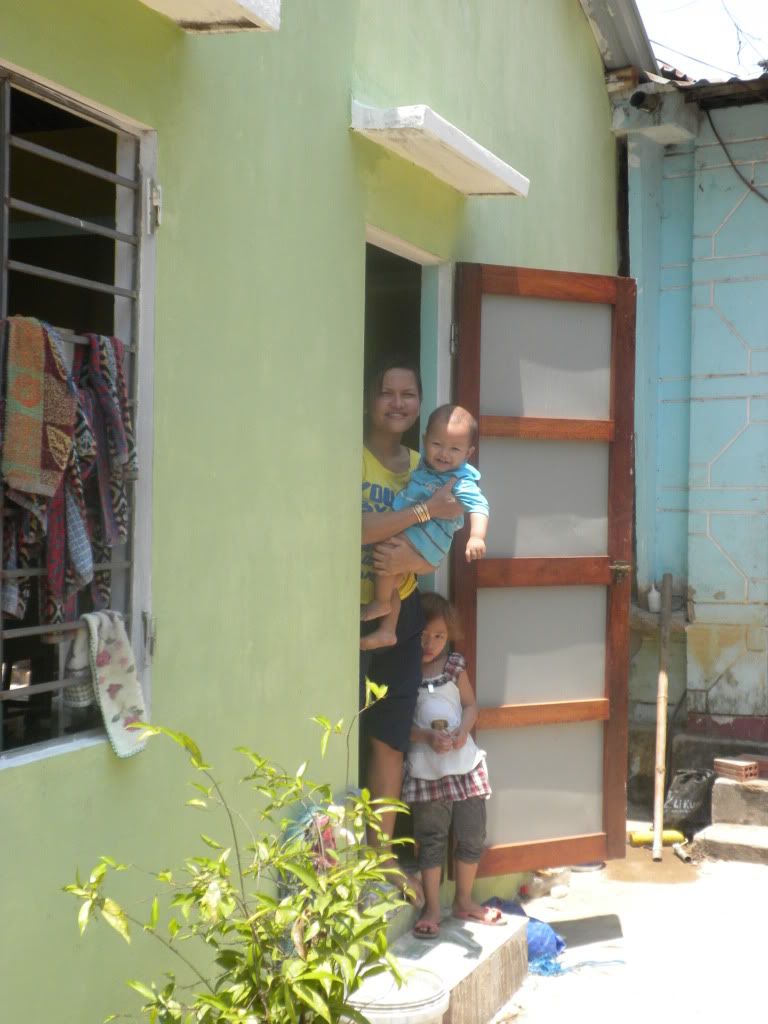
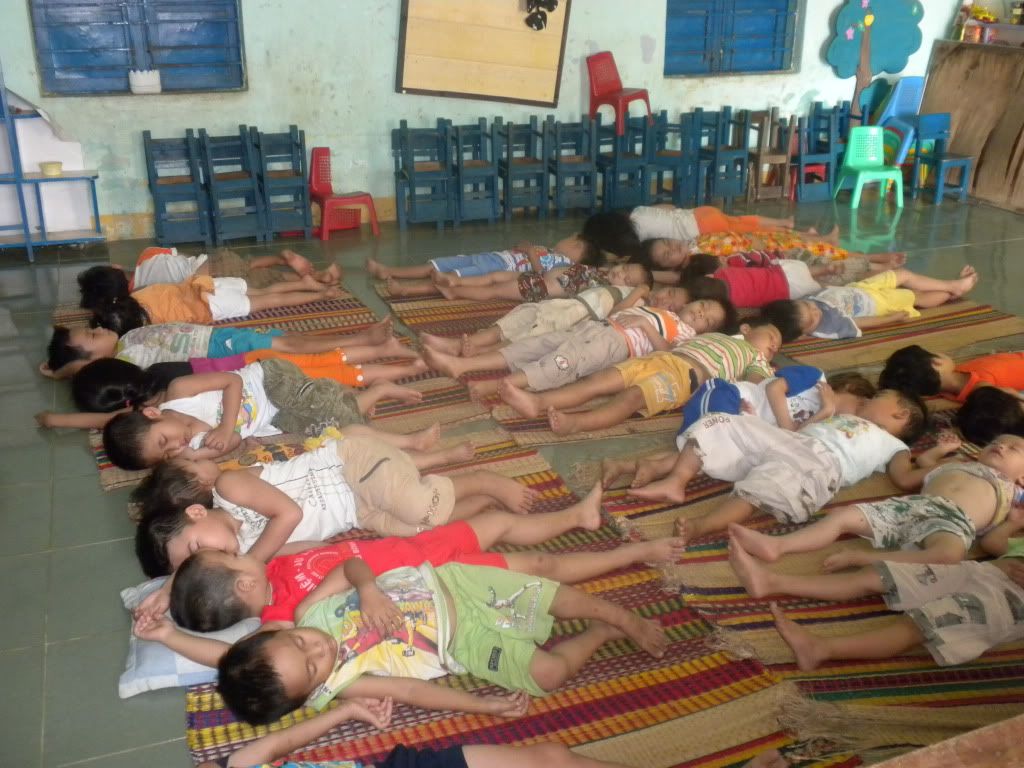
Just outside we were shown a huge war memorial, with a long list of village victims. We learned that Vietnam only knows about 300 different last names (which are listed first) and that Nguyen is very popular, since a famous emperor carried that name. The people believe that it protects them from theft, hoping their name will scare potential perpetrators off. Mr. Phong also shared that the Vietnamese initially used Chinese characters, but that they found that difficult. When Alexandre de Rhodes, the famous French explorer, wrote out their language in the Roman alphabet they quickly switched. Makes reading street signs a lot easier for us! We went to visit a family shrine next. Some families honor hundreds of ancestors in their shrines. We couldn’t go in, since the doors were locked.
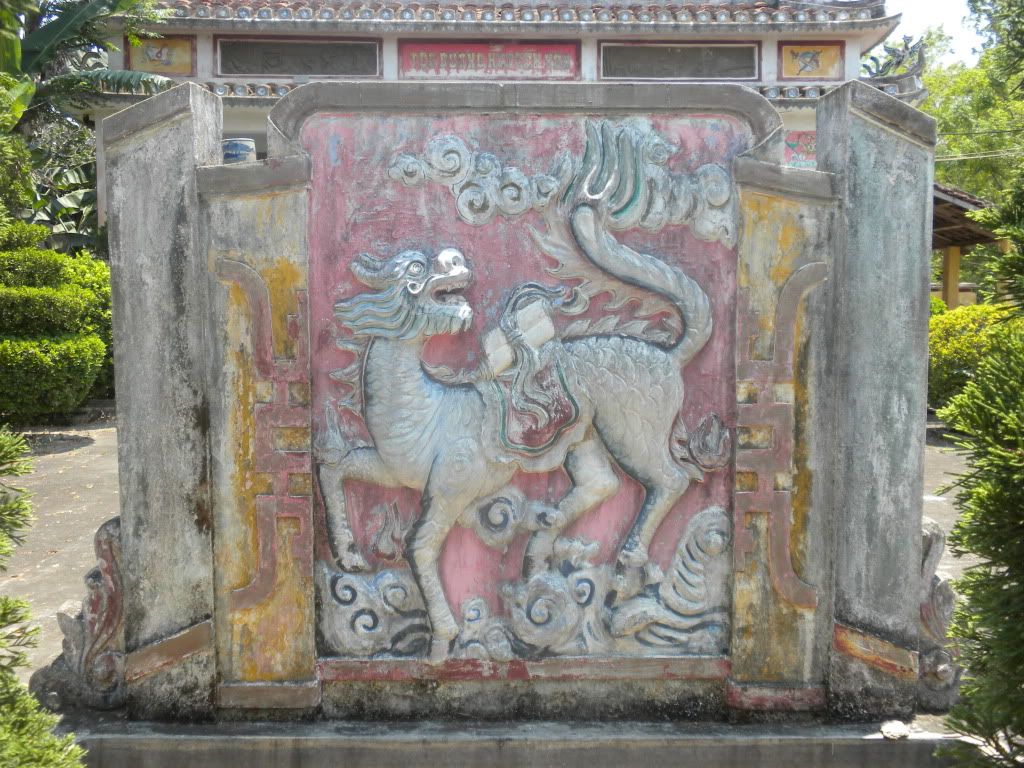
Mr. Phong then took us to an old house further down the road, where we sat down with an old man for some tea. His house had seen some action during the war; the bullet holes in a door were proof of that. Mr. Phong told us the old man was one of the few people left traditionally educated in Confucianism. Numbers are important to Confucians and they have books in which they can look up which dates are favorable for marriage or building a new house. Mr. Phong said that the gods can be tricked by not holding a wedding ceremony, just a party on a less favorable day, and how you can start by putting down one cornerstone of a house in case you don’t have money for the rest on a favorable day. The old man was also a palm reader and we asked Mr. Phong to translate for us. Apparently I’m going to become a successful businessman, whilst Francesca will be a renowned writer. Go us!
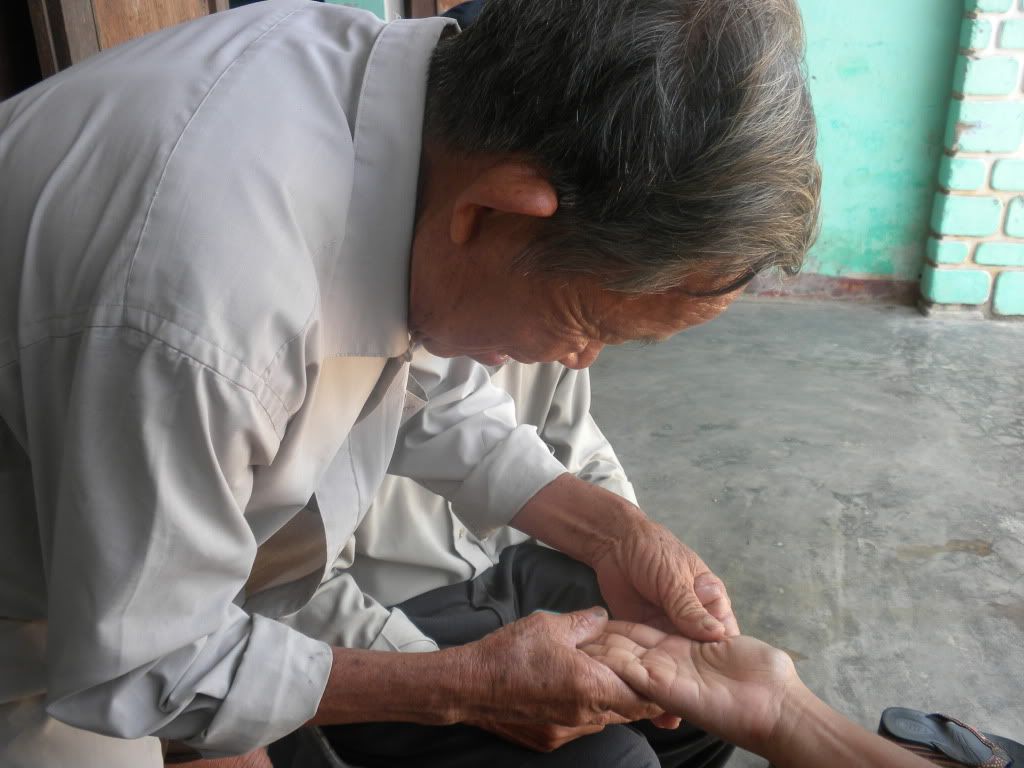
Francesca and I thanked the old man and we walked back to Mr. Phong’s house. On the way back we stopped at a house where some people were eating these tiny snails. We were invited to try a few, sat down and were given a turn to pluck the little snacks out of their shells. It was pretty easy and they tasted a little salty, but pretty good nonetheless. Since we didn’t have breakfast Francesca and I were hungry as hell. We were glad to hear we were going back to his house for lunch. This amazing stack of food, freshly prepared by Mr. Phong’s wife, was put in front of us. We got morning glory, tuna steak, winter melon and shrimp soup, pork and sweet potato rolls and rice. It all tasted so good, and we finished plate after plate. Plate after plate was refilled as well until our bellies were round. Around 1:45 PM the party ended. Mr. Khong showed up and we were driven back to town. I took some pictures of Francesca on the back of Mr. Phong’s bike, whilst she held on for dear life. Awesome!
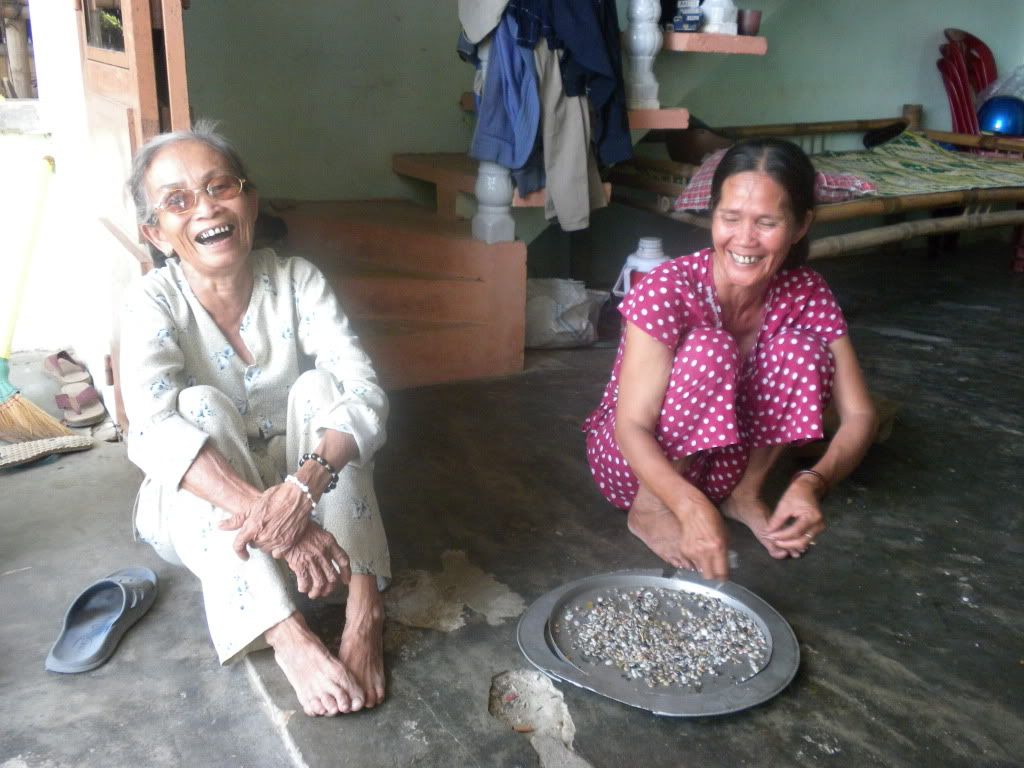
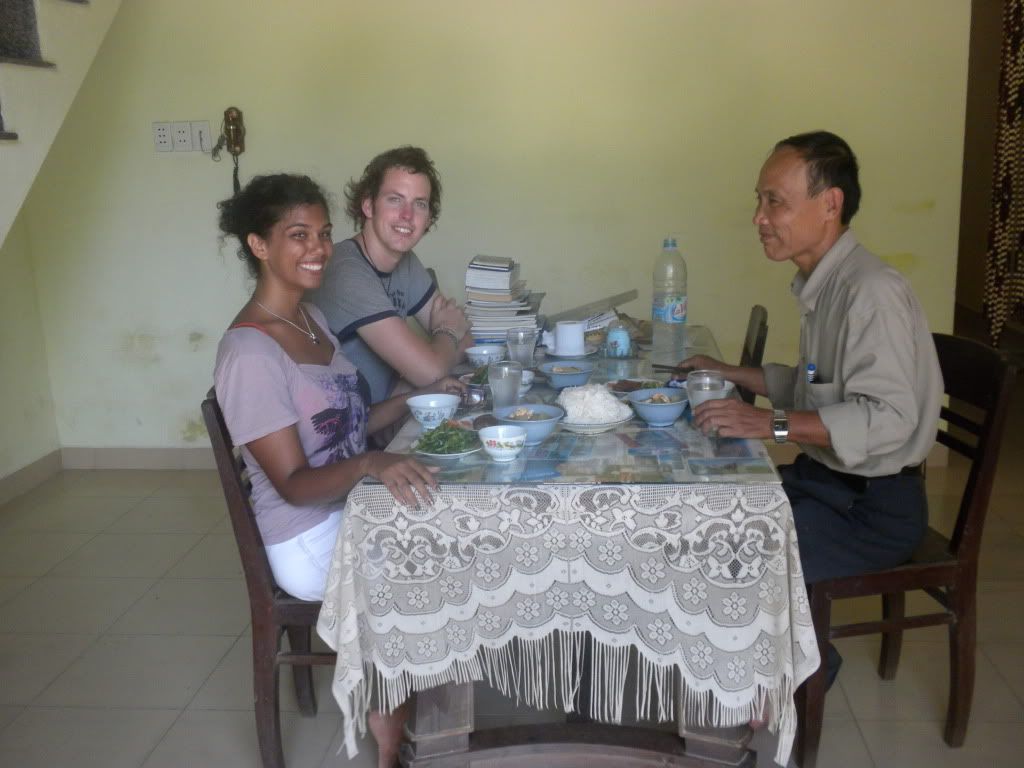
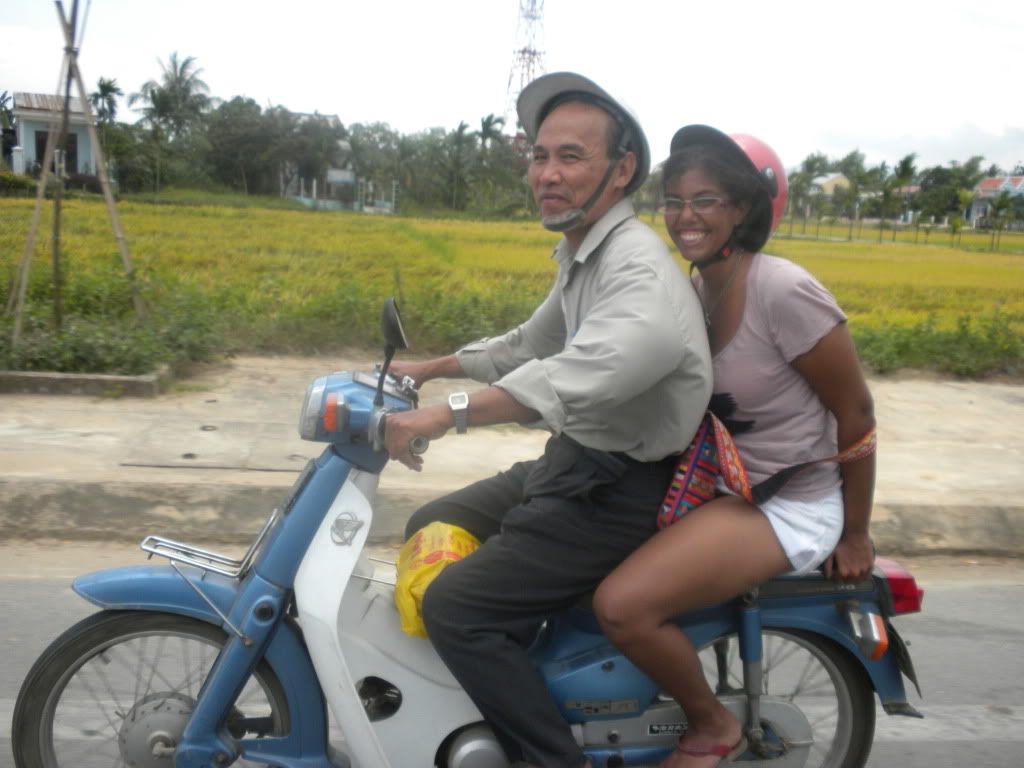
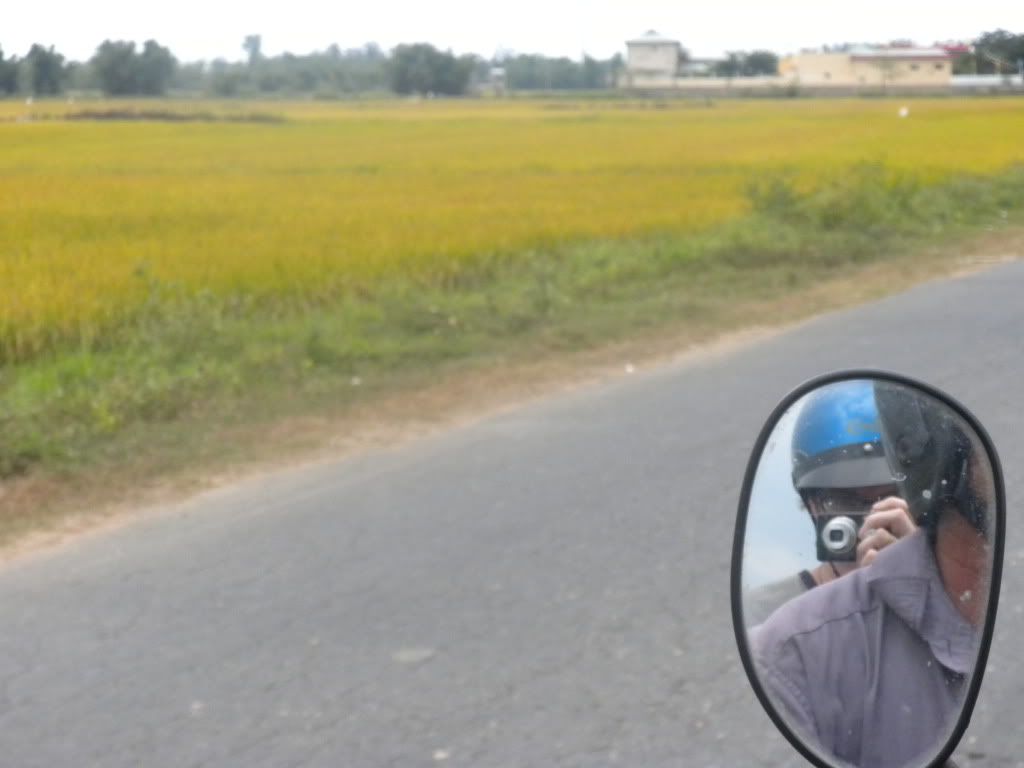
We still had two historical sites left to visit in town, so we asked them to drop us off near the Bridge. We thanked Mr. Phong for a wonderful day, gave him a handsome tip and walked off. The Quan Cong Temple was built in the 1653, and dedicated to a highly esteemed Chinese General. It looked like it was about to rain, so Francesca and I hurried on, having a quick look at the local market before heading to the Cantonese Assembly Hall. Built in 1885, it has a calm courtyard with ornate statuary. We had a peek at the half-hidden back yard and its kitschy pastel dragon statues. It had been a long day and we decided to make our way back to the hotel. We rested for the remainder of the afternoon, whilst I picked up a salad and pizza for dinner.
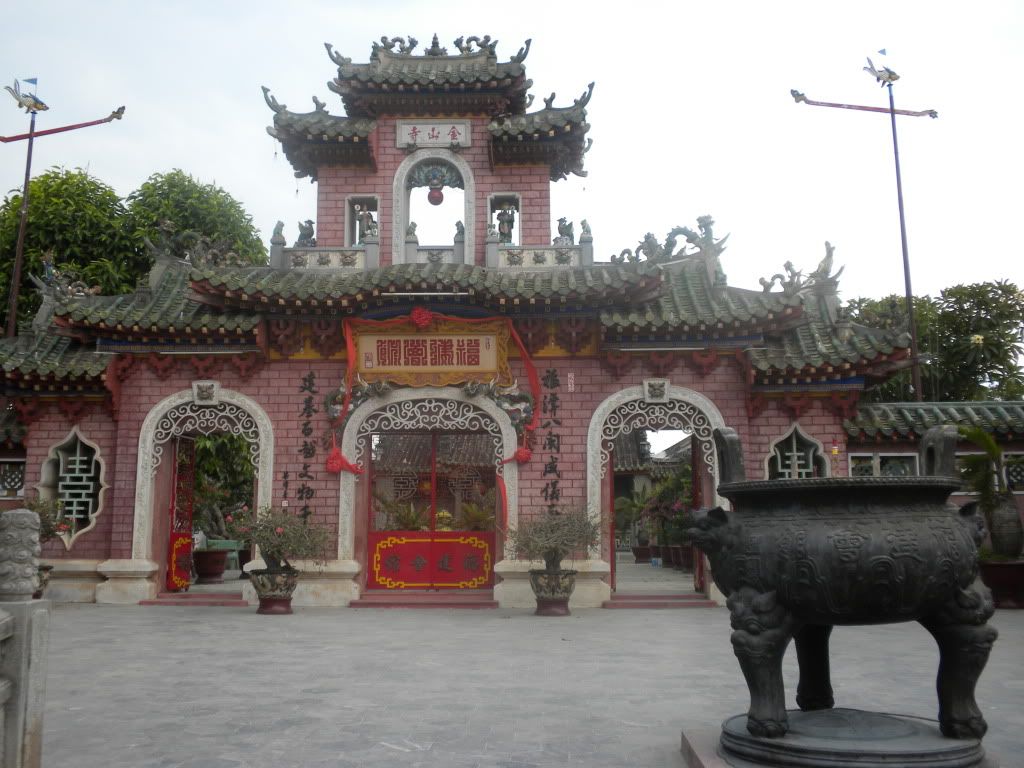
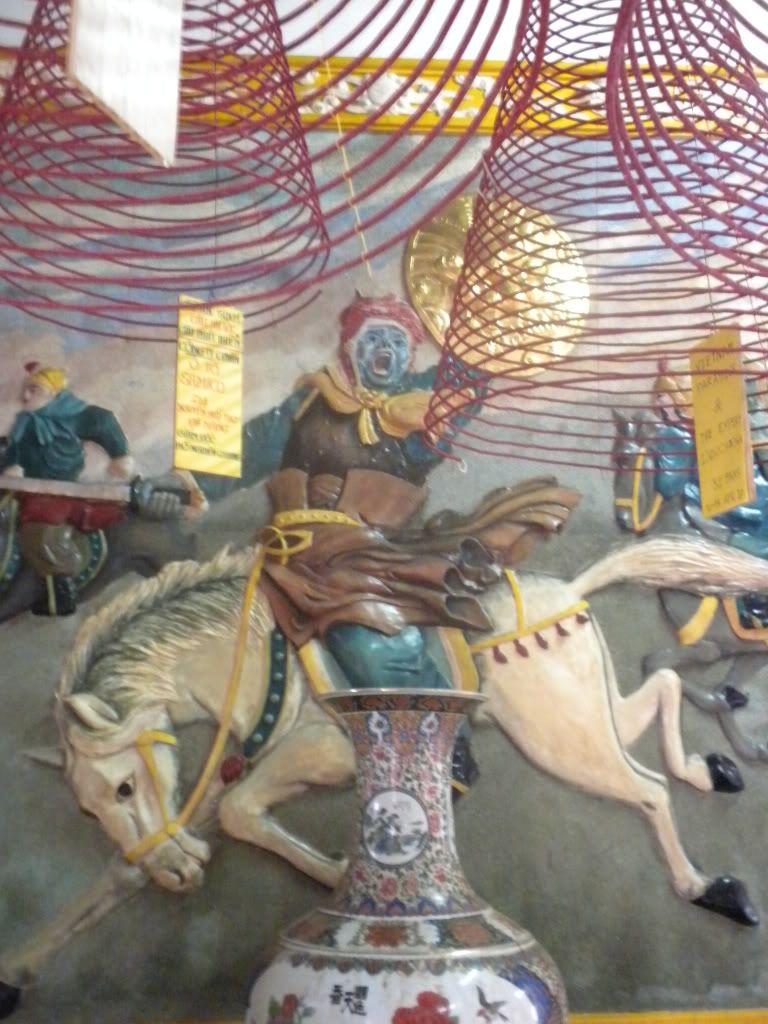
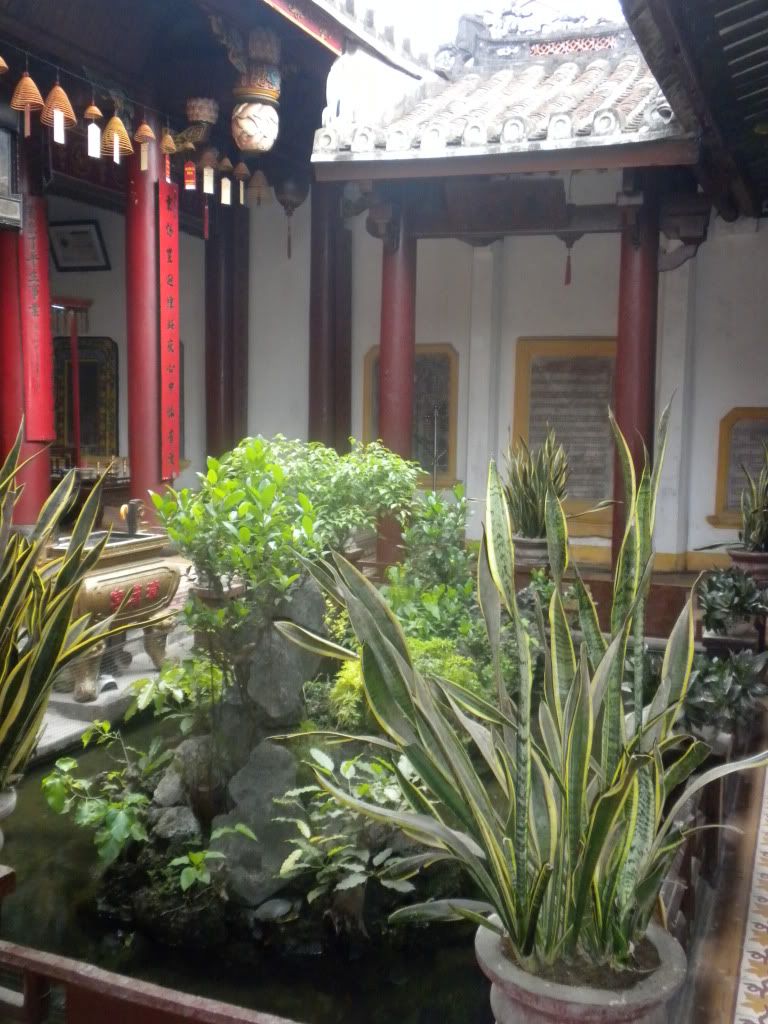
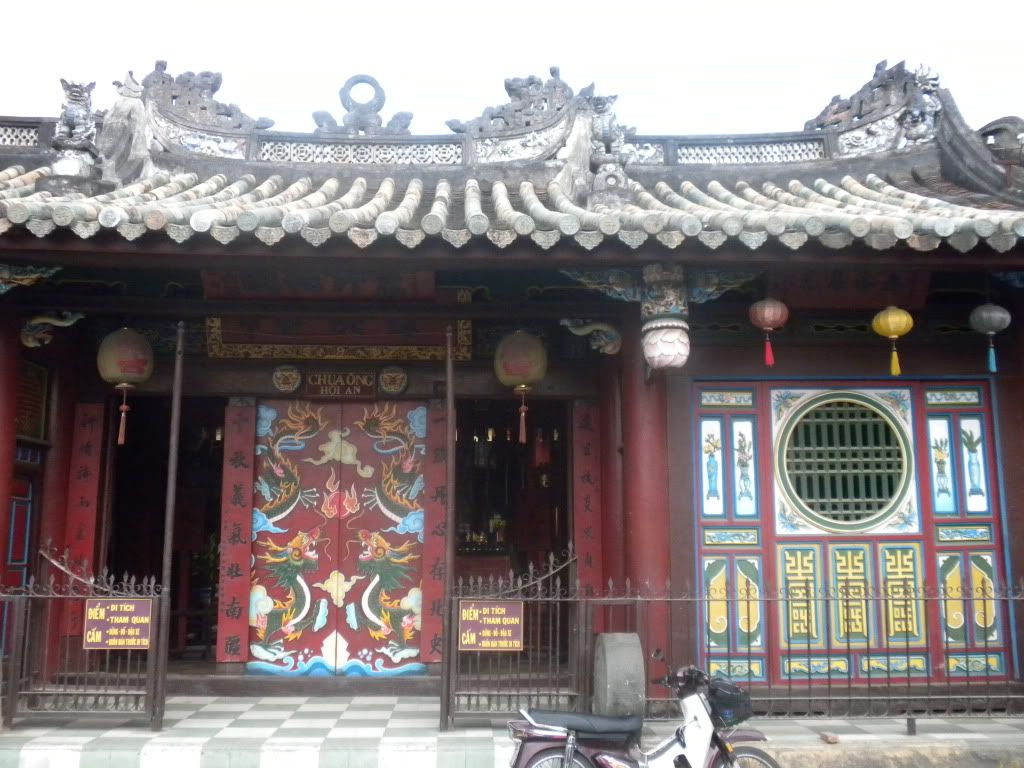
The 20th of April was reserved for the My Son Holy Land. We wanted to do the tour to these ancient Champa Temples, but also planned to leave Hoi An that day. We confirmed with the hotel owners that we’d be back before 1:00 PM so we’d have time to make it to the train station in Danang. They said yes and we left early that morning for a long drive to My Son. Around 10:00 AM we arrived at My Son and were explained that we were going to be shown several sets of ruins, but that the first one would be the main one.
Our amusing guide took us by vans and jeeps to the starting point of the circle and off we went. Francesca and I tried to stay ahead of the troop, making sure to follow our guide closely. We arrived at the old, reddened ruins shortly after. Our guide told us My Son is a cluster of temples constructed between the 4th and the 14th century A.D. by the kings of Champa, an ancient Vietnamese people. He was quite eager to tell us some of the temples had been built before Angkor Wat, and pointed out the skills of the Cham. The Cham had dedicated the temples to the worship of the god Shiva as he is known under various local names, the most important of which is "Bhadresvara."
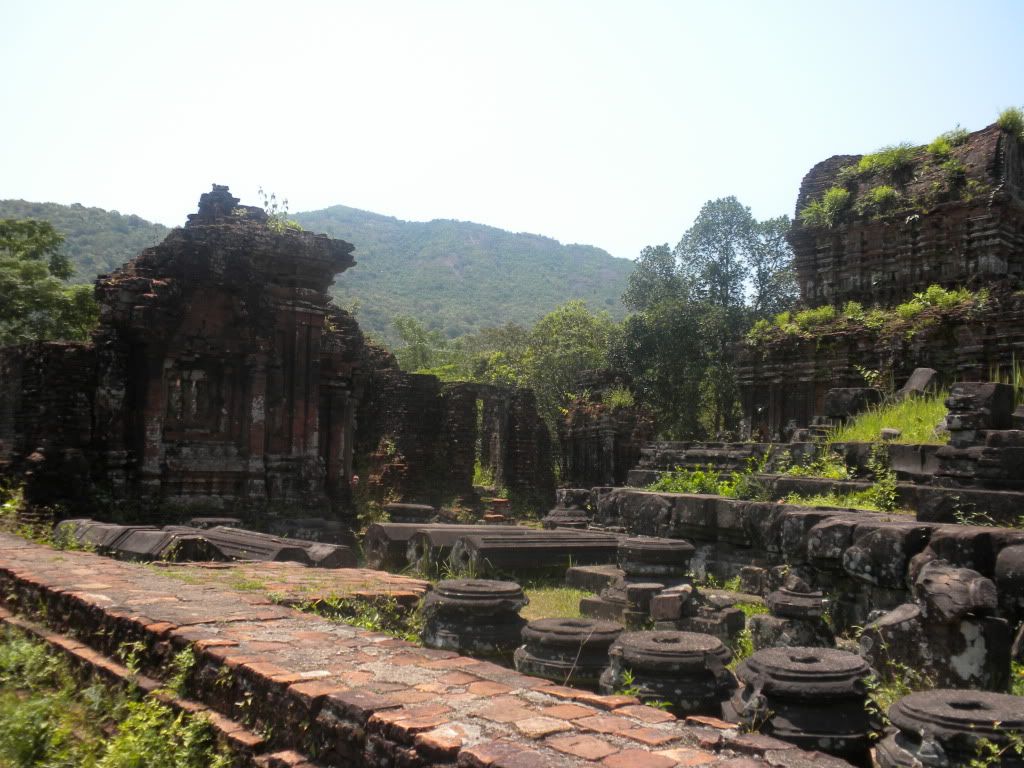
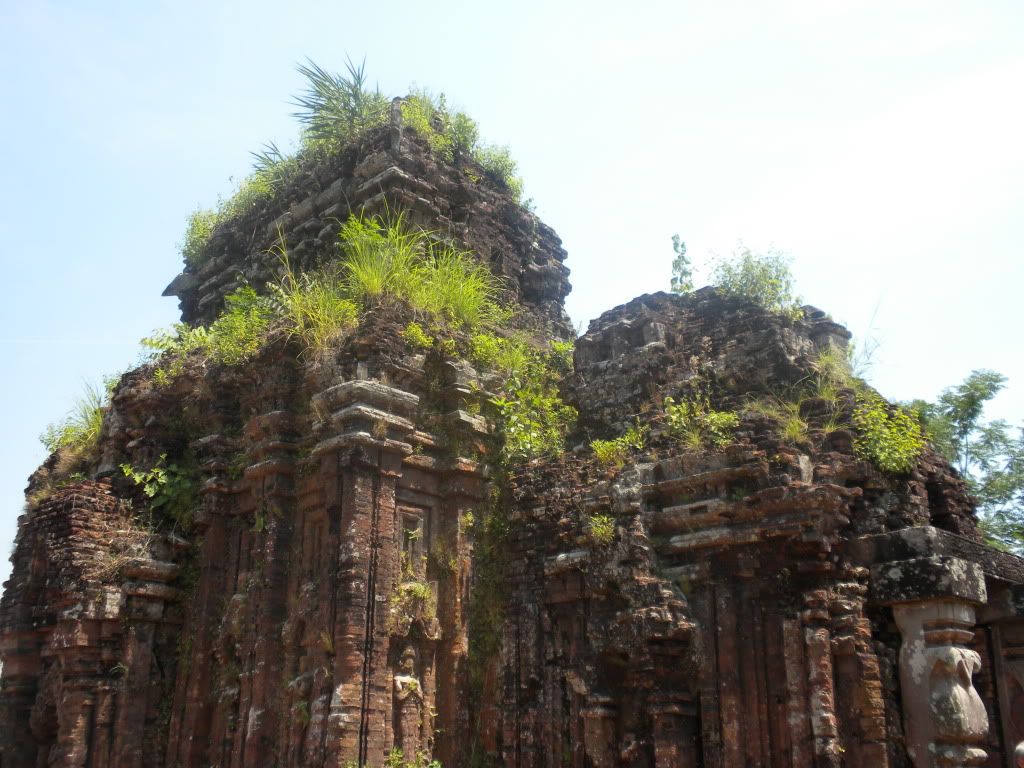
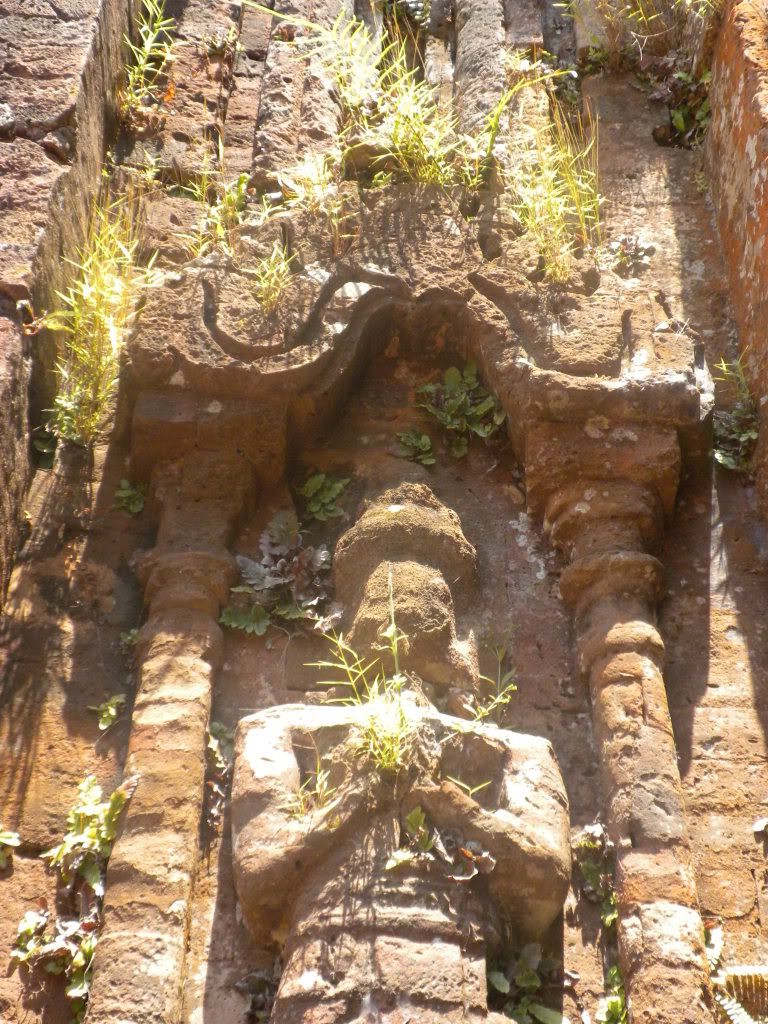
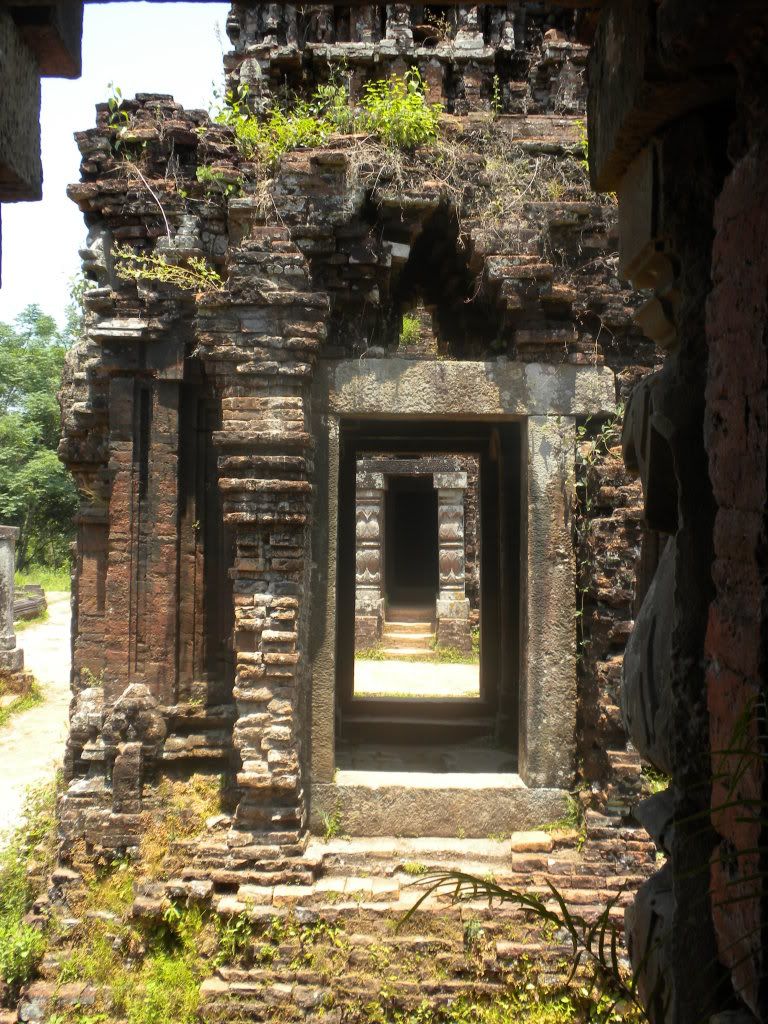
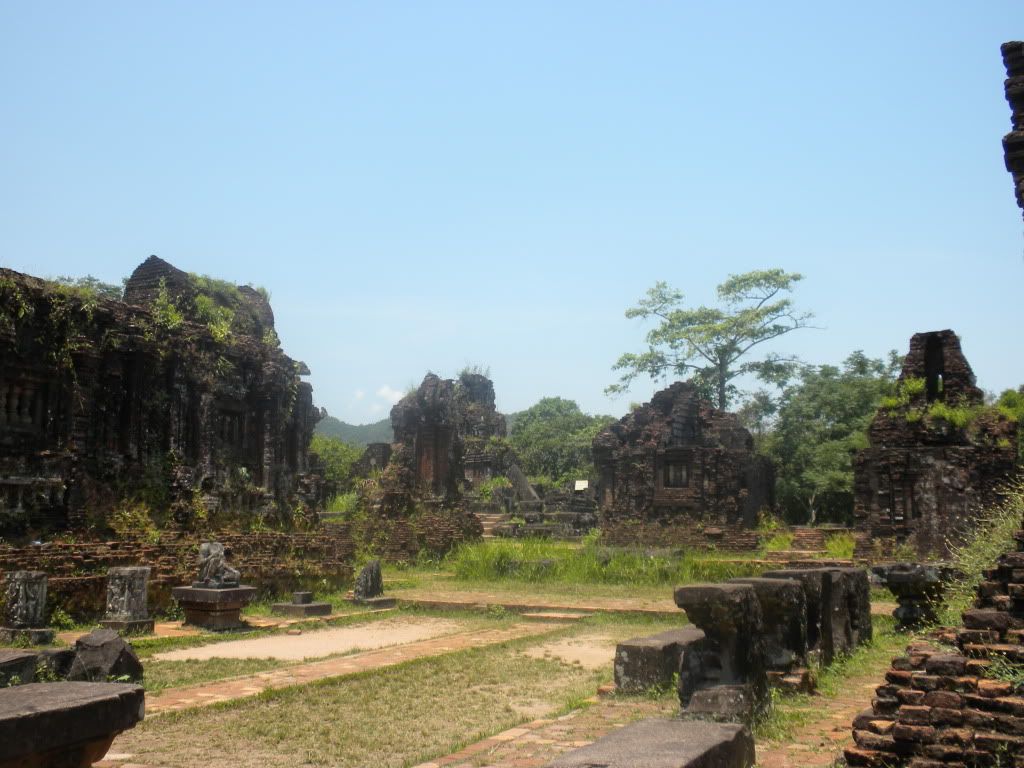
Unfortunately, since we have already seen Borobudur and Angkor Wat we had to admit these temples fell a bit short of those epic complexes. Furthermore, the sun was beating down on us and we needed all the shade we could get. Our guide led us around the different buildings, all in varying states of ruination. It was sad to learn most larger statues had been beheaded and taken overseas by the French. We also learned about now lost the impressive building technique the Cham had found: they had a means to layer bricks perfectly without using mortar. When we compared their old work to new restored walls we saw a definite difference. I’d hire the Cham!
The guide explained we could do the rest of the walk on our own, and left us to go explore. Francesca and I were getting worried about the time we’d get back to Hoi An, so we asked him to help us out. Our fears were confirmed: we’d get back to Hoi An too late and we’d miss the train. Luckily this guy was nice and brought us back to the parking lot, where he asked around if any buses were leaving a little earlier. He even made sure to ask them to drop us off at our hotel. We were fine with skipping the remaining ruins, so a little later our new driver sped off and before 1:00 PM we were back in Hoi An.
The hotel owner’s son was waiting and helped us put our bags in his car. He’d drive us to Danang’s train station, just up the coast from Hoi An. He also promised to show us the Marble Mountains along the way. That’s all we needed to hear! I grabbed Francesca some snacks for the road and off we drove. Not doing a day trip to the Marble Mountains, as we had initially planned, turned out to be a good decision: the big rock by the side of the road with a large pagoda on it looked unexciting. The car stopped and I got out to snap a few pictures. About 30 minutes later we arrived in Danang and were dropped off at the train station. Whilst Francesca waited with the bags I set out to purchase our tickets. That didn’t take too long and at that point all we had left to do was wait. And wait… And wait… It turned out our train was 30 minutes late!
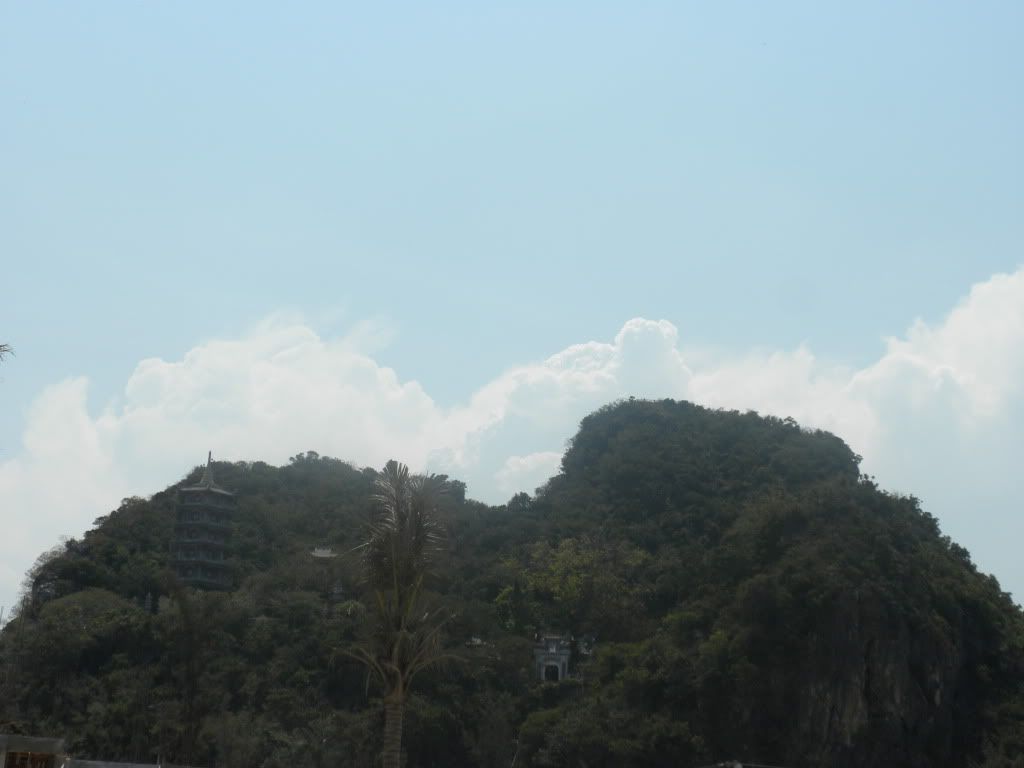
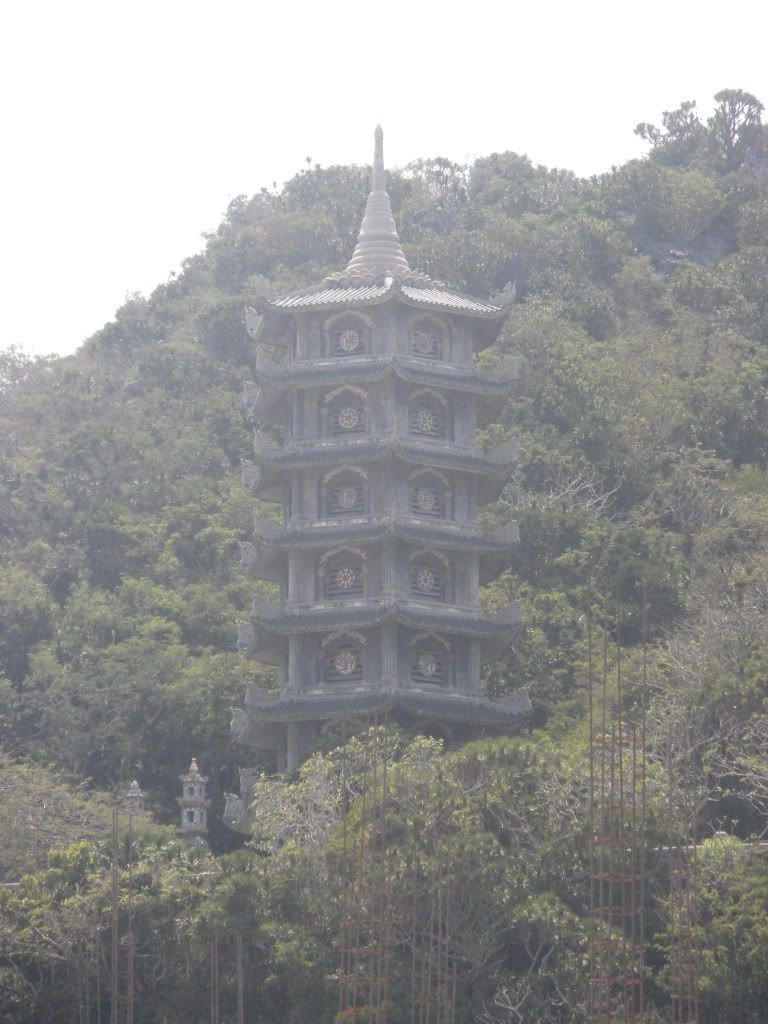
Around 3:00 PM we were finally en route to Hue. We had a lovely scenic drive ahead of us, which was also the sole reason we had chosen to travel by train. We were not disappointed as we zigzagged along the coast: water and deserted beaches on one side, dense jungle on the other. We saw the train disappear into tunnels ahead of us until the darkness enveloped us as well. Francesca was equally (or more) excited by the food carts being pushed through the train. One of them brought her chicken legs! I got her one, but it was demolished before I could even take a picture of her with it. I had to get her a second one, which she also got devoured. Apparently someone was in dire need of poultry! And so we arrived in Hue a few hours later, got picked up by some of our new hotel’s staff and were taken by taxi to the Ngoc Hung Hotel. Francesca rested up since she felt a little tired, but I went out to grab myself a salmon steak on mashed potatoes and her a chicken breast. The food tasted amazing and we knew we’d be back at the Hot Tuna restaurant on the corner.
